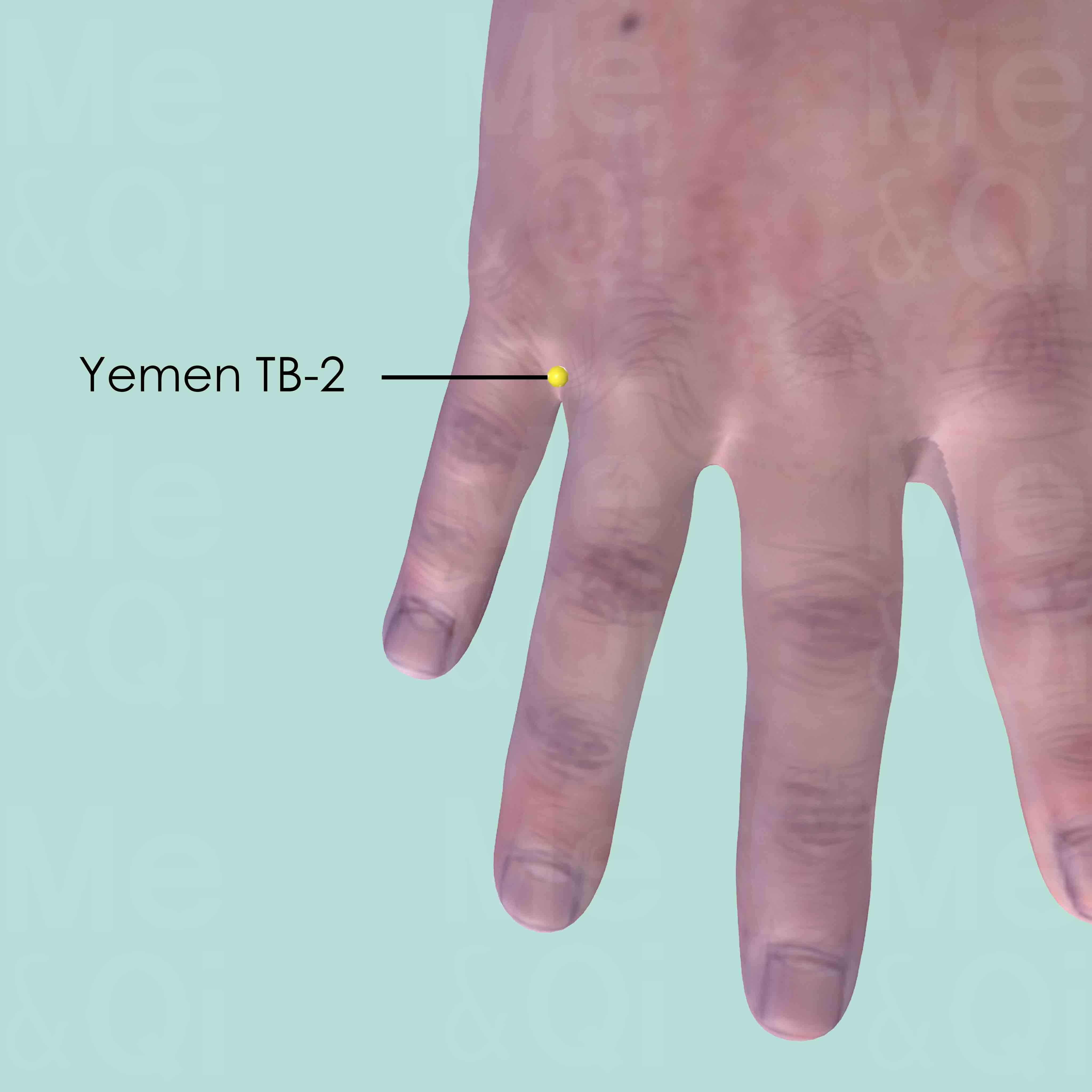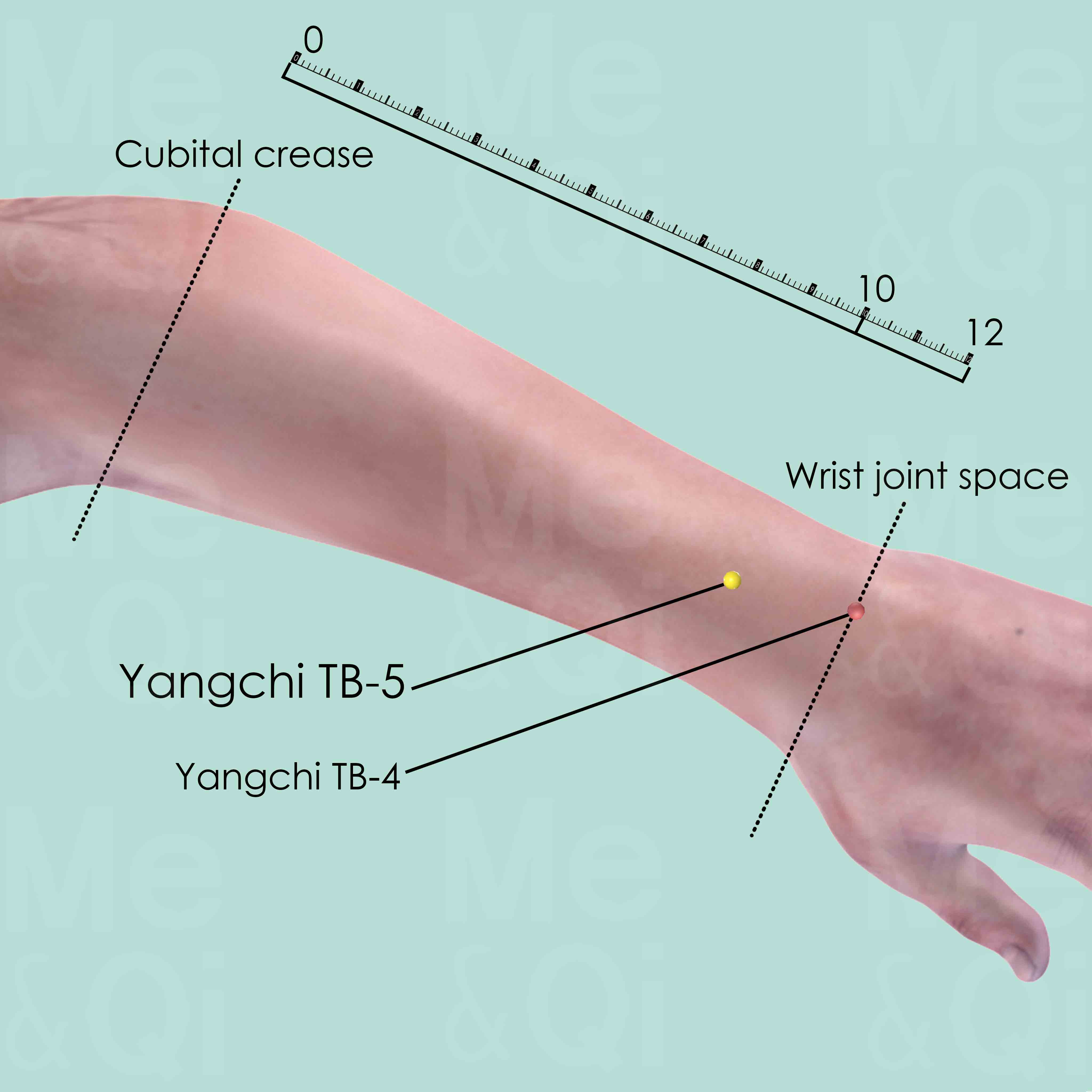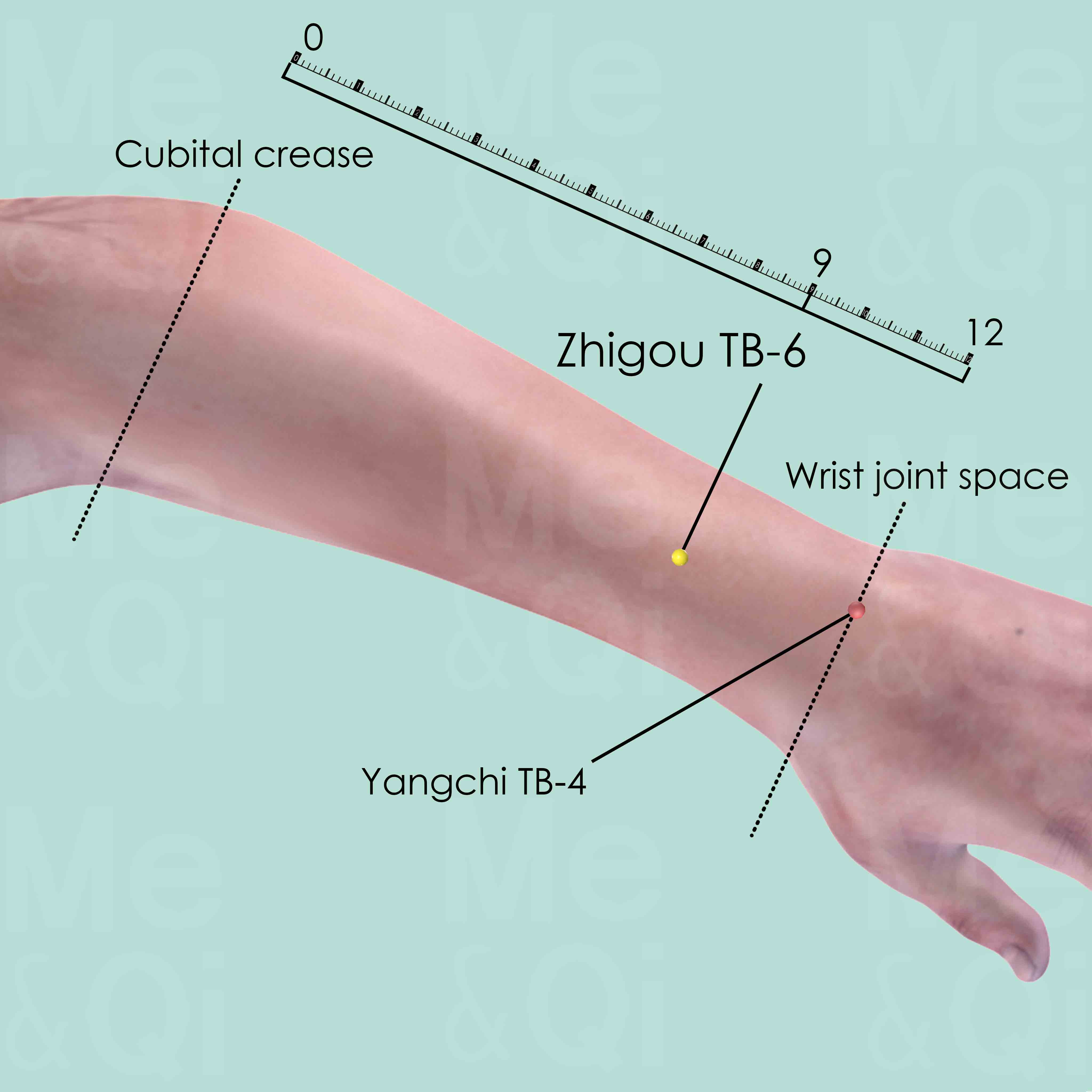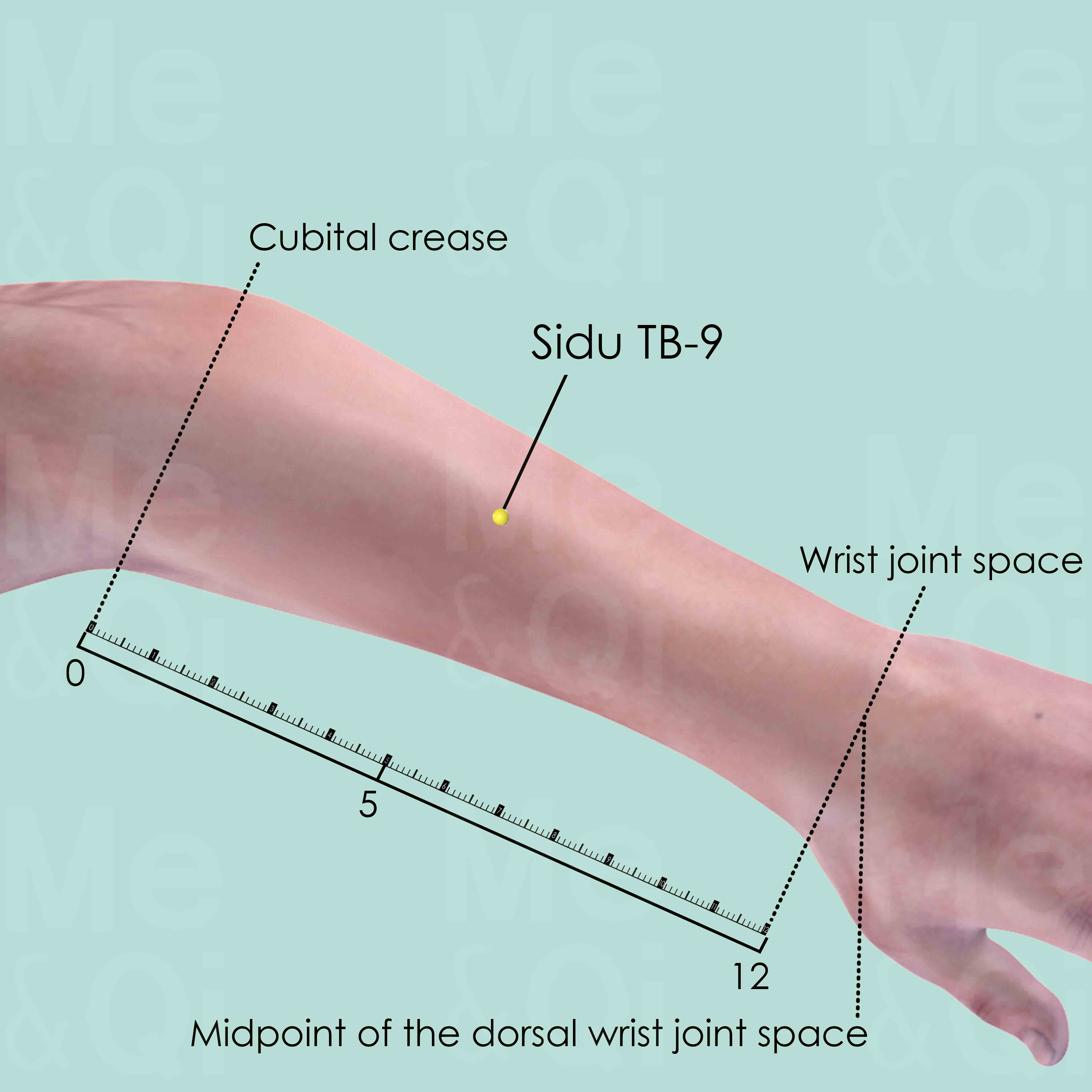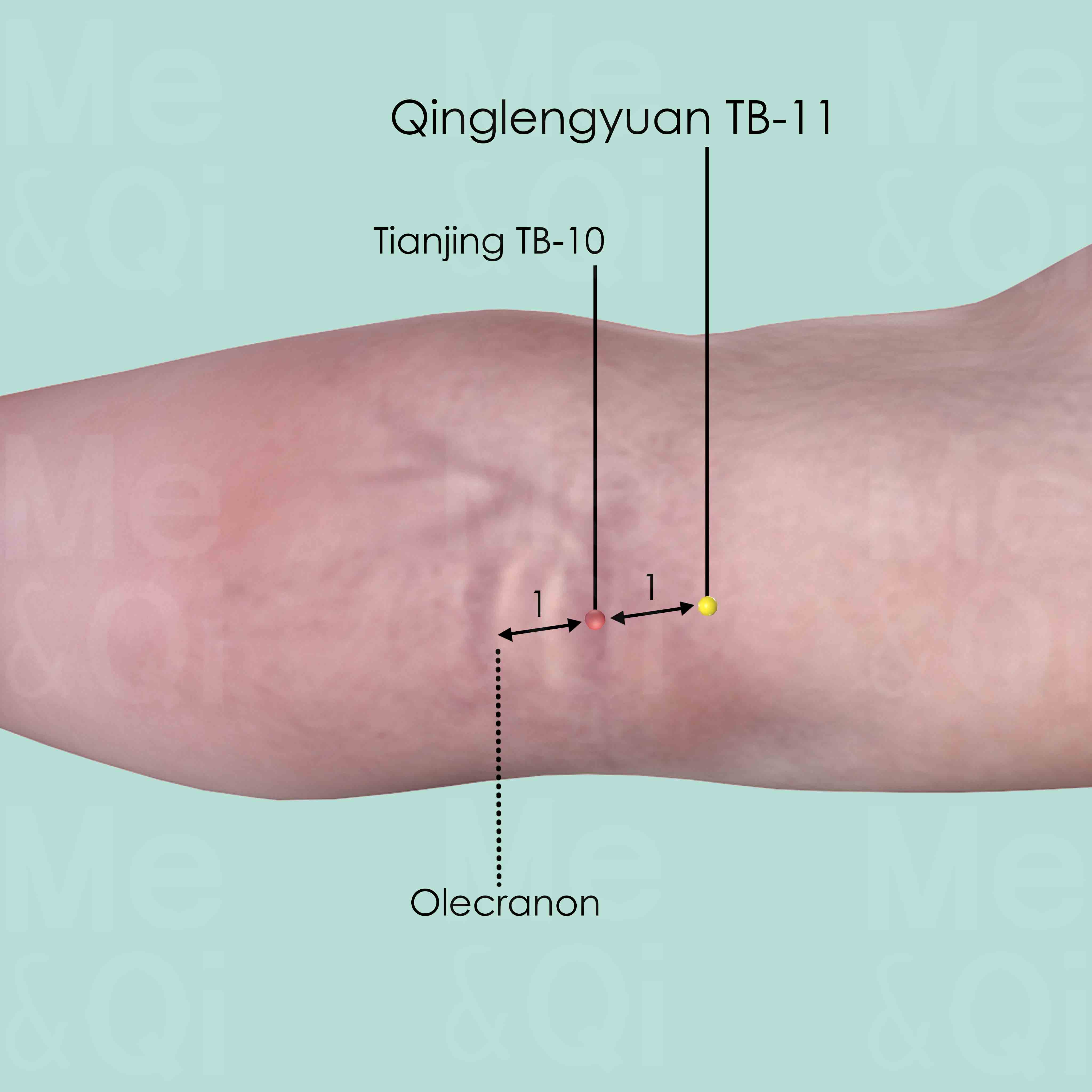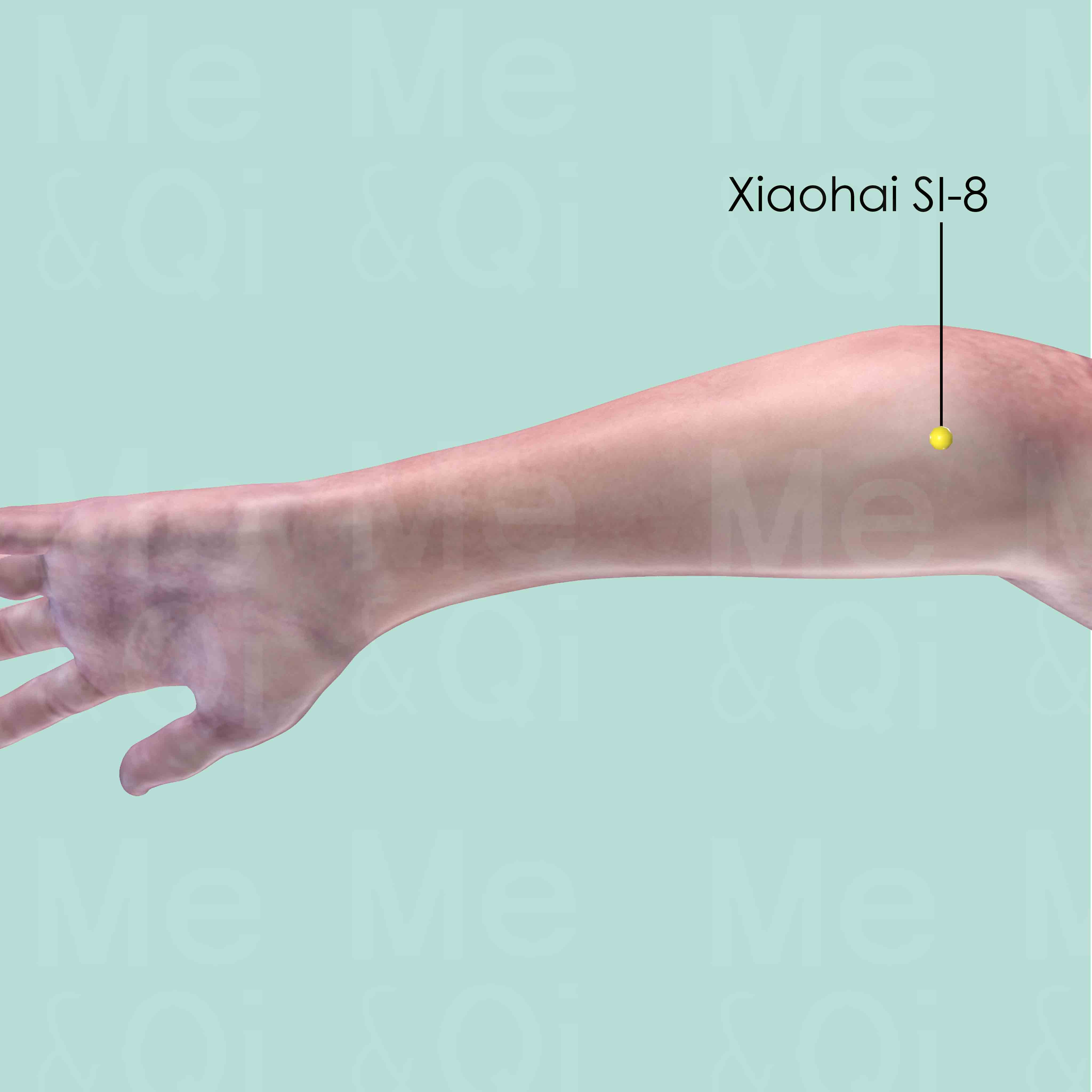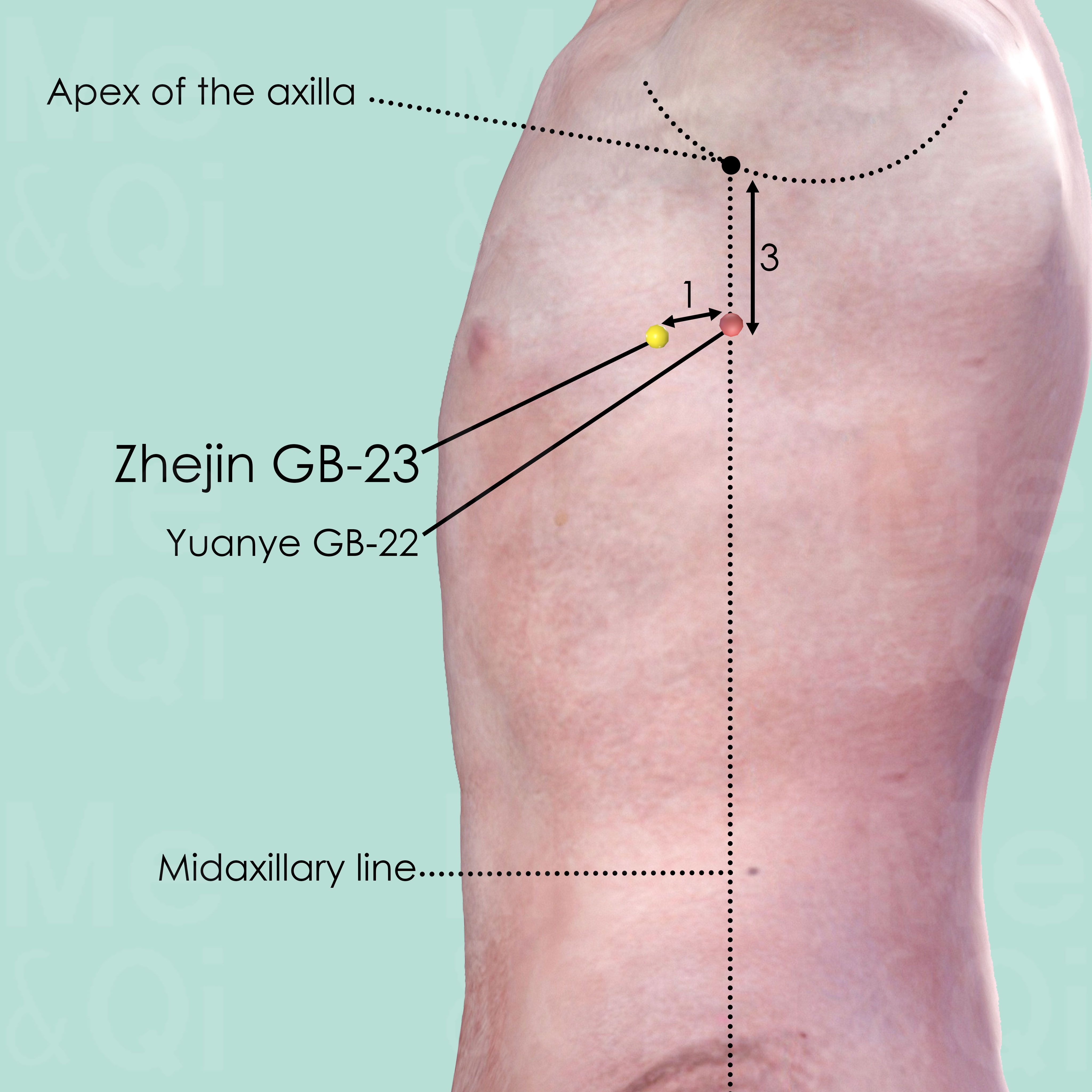Painful Extremitiesaccording to TCM
Symptom family: Limb Pain and Discomfort
Sub-symptom(s): Sore Legs Arm Pain Upper Arm Pain Forearm Pain
Root Causes of Painful Extremities in TCM
Explore below more details about what might cause Painful extremities according to TCM.
Cold
In TCM "Cold" as a pattern of disharmony refers to a specific type of imbalance within the body's systems, often linked to a deficiency or weakness. It's not about feeling physically cold or having a common cold, but rather a metaphorical description of certain symptoms and underlying conditions. When a TCM practitioner says someone suffers from "Cold," it usually implies that the body's Yang energy, which is warm and active, is insufficient or overpowered by Yin energy, which is cool and passive. Symptoms of Cold in TCM can include a general feeling of coldness, cold limbs, pale complexion, low energy, slow metabolism, and a preference for warmth. ... see more
Cold Patterns That Can Lead to Painful Extremities
Common Symptoms: High Fever Fever Without Perspiration Headaches Neck Pain Stiff Neck Focal Distention Chest Distension Congested Nose
| Pattern Name | Relevant Symptoms | Relevant Formulas |
|---|---|---|
| Wind-Cold-Damp invading with Qi Deficiency | pain extremities, High fever, Fever without perspiration, Headaches, Neck pain, Stiff neck, Painful extremities, Focal distention, Chest distension, Congested nose, Noisy breathing, Coughing... see more | Ren Shen Bai Du San |
| Cold in the Uterus | Sore legs, Diarrhea, Lack of appetite, Generalized fatigue, General weakness, Thin vaginal discharge... see more | Wen Jing Tang | Shao Fu Zhu Yu Tang | Wen Qi Hua Shi Tang |
Yin Deficiency
Yin deficiency in TCM is a pattern of disharmony characterized by a depletion of the body's Yin energy, which represents the cooling, moistening, and nurturing aspects of our physiology. This condition often arises from factors like chronic stress, overwork, insufficient rest, or prolonged illness. Symptoms of Yin deficiency can include a sensation of heat, especially in the afternoon or evening, night sweats, insomnia, a dry mouth or throat, and a red tongue with little coating. There might also be a general feeling of restlessness or irritability. Since Yin is essential for balancing the body's active and warm Yang energy, its deficiency leads to a relative excess of Yang, manifesting as heat or dryness symptoms.... see more
Yin Deficiency Patterns That Can Lead to Painful Extremities
| Pattern Name | Relevant Symptoms | Relevant Formulas |
|---|---|---|
| Kidney Yin Deficiency | Limbs pain, Perspiration, Back pain, Hearing loss, Dry mouth and throat at night, Lower back pain, Constipation, Scanty and dark urine, Infertility, Premature ejaculation, Generalized fatigue, General weakness, Depression, Anxiety, Heat sensation in palms, Evening heat sensation, Flushed cheekbones, Menopausal hot flashes, Preference for sipping, Evening anxiety... see more | Liu Wei Di Huang Wan | Zuo Gui Wan |
Qi Deficiency
Qi Deficiency in TCM is like running low on battery power. Qi is the vital energy that powers every function in your body. When there's a Qi Deficiency, it means your body doesn't have enough of this essential energy. This can make you feel tired all the time, weak, or even cause shortness of breath. It's similar to how you feel when you haven't had enough sleep or nutritious food. Your body just doesn't have the energy it needs to perform at its best. Unlike modern medicine, which often focuses on specific physical causes for fatigue and weakness, TCM views Qi Deficiency as an overall energy depletion that affects your entire well-being, and it seeks to replenish and balance this vital energy.... see more
Qi Deficiency Patterns That Can Lead to Painful Extremities
| Pattern Name | Relevant Symptoms | Relevant Formulas |
|---|---|---|
| Wind-Cold-Damp invading with Qi Deficiency | pain extremities, High fever, Fever without perspiration, Headaches, Neck pain, Stiff neck, Painful extremities, Focal distention, Chest distension, Congested nose, Noisy breathing, Coughing... see more | Ren Shen Bai Du San |
Wind
In TCM "Wind" is a concept that represents a pattern of disharmony, often characterized by its sudden and unpredictable nature, much like a gusty wind changing direction without warning. This pattern is associated with symptoms that come and go quickly or move around the body, such as itching, tremors, or even certain types of pain. Wind is considered to be a primary cause of illnesses that have these rapidly changing characteristics. In TCM, external Wind often refers to illnesses that start suddenly, like the common cold, believed to be caused by external pathogenic factors like climatic changes. On the other hand, internal Wind can be linked to internal imbalances and can manifest in conditions like dizziness or spasms. ... see more
Wind Patterns That Can Lead to Painful Extremities
| Pattern Name | Relevant Symptoms | Relevant Formulas |
|---|---|---|
| Wind-Cold-Damp invading with Qi Deficiency | pain extremities, High fever, Fever without perspiration, Headaches, Neck pain, Stiff neck, Painful extremities, Focal distention, Chest distension, Congested nose, Noisy breathing, Coughing... see more | Ren Shen Bai Du San |
Dampness
"Dampness" in TCM is a concept that describes a pattern of disharmony where the body accumulates excess moisture. Imagine the heavy, sticky feeling you get on a very humid day; that's similar to what dampness feels like internally. It can manifest as a sense of heaviness, bloating, sluggishness, or even a foggy mind. This condition is often thought to arise from environmental factors like living in a damp place, dietary habits that promote moisture in the body, or internal imbalances that hinder the body's ability to process fluids properly. In TCM, dampness can obstruct the normal flow of energy and fluids in the body, leading to various symptoms.... see more
Dampness Patterns That Can Lead to Painful Extremities
| Pattern Name | Relevant Symptoms | Relevant Formulas |
|---|---|---|
| Wind-Cold-Damp invading with Qi Deficiency | pain extremities, High fever, Fever without perspiration, Headaches, Neck pain, Stiff neck, Painful extremities, Focal distention, Chest distension, Congested nose, Noisy breathing, Coughing... see more | Ren Shen Bai Du San |
Kidney
In TCM the Kidneys are regarded as the body's most fundamental reservoir of Essence, known as Jing, which influences growth, reproduction, and aging. They are not just organs for filtering blood, but a holistic system governing vital life forces. When the Kidneys malfunction in TCM, it can manifest as a variety of health issues, such as chronic fatigue, reproductive problems, imbalances in fluid metabolism leading to edema or dryness, lower back pain, and a sense of fear or insecurity.... see more
Kidney Patterns That Can Lead to Painful Extremities
| Pattern Name | Relevant Symptoms | Relevant Formulas |
|---|---|---|
| Kidney Yin Deficiency | Limbs pain, Perspiration, Back pain, Hearing loss, Dry mouth and throat at night, Lower back pain, Constipation, Scanty and dark urine, Infertility, Premature ejaculation, Generalized fatigue, General weakness, Depression, Anxiety, Heat sensation in palms, Evening heat sensation, Flushed cheekbones, Menopausal hot flashes, Preference for sipping, Evening anxiety... see more | Liu Wei Di Huang Wan | Zuo Gui Wan |
Uterus
In TCM the Uterus (or "Bao Gong") is not just a reproductive organ but a vital system closely linked to Kidney energy, responsible for menstrual health, fertility, and pregnancy. It's also connected to the Heart and Liver, reflecting the importance of emotional and blood health in reproductive wellness. In TCM, the Uterus is seen as a reservoir of Blood and Qi, crucial for reproductive health and general vitality. When the Uterus malfunctions or is imbalanced, it can lead to menstrual irregularities, infertility, miscarriages, or menopausal symptoms. Additionally, there might be symptoms like lower abdominal pain or emotional disturbances such as mood swings, often linked to Liver Qi stagnation. These manifestations highlight the TCM perspective that the health of the Uterus is intertwined with the overall balance of energy and blood in the body, as well as emotional well-being.... see more
Uterus Patterns That Can Lead to Painful Extremities
| Pattern Name | Relevant Symptoms | Relevant Formulas |
|---|---|---|
| Cold in the Uterus | Sore legs, Diarrhea, Lack of appetite, Generalized fatigue, General weakness, Thin vaginal discharge... see more | Wen Jing Tang | Shao Fu Zhu Yu Tang | Wen Qi Hua Shi Tang |
TCM Herbal Formulas for Painful Extremities
Explore below some TCM herbal formulas used to address painful extremities, organized by cause and by formula type.
- By Cause
- By Formula Type
- Cold
- Yin Deficiency
- Qi Deficiency
- Wind
- Dampness
- View More Causes
- Formulas that nourish yin and tonify
- Formulas that invigorate blood and dispel blood stagnation
- External formulas for external disorders
- Formulas that warm the middle and dispel cold
Top Formula for Cold:
Ren Shen Bai Du San
Suitable for Cold patterns that may cause painful extremities, such as Wind-Cold-Damp invading with Qi Deficiency
Learn moreAll Formulas Recommended for Painful Extremities Caused by Cold
| Formula | Patterns Suitable For |
|---|---|
| Ren Shen Bai Du San | Wind-Cold-Damp invading with Qi Deficiency |
| Wen Jing Tang | Cold in the Uterus |
| Shao Fu Zhu Yu Tang | Cold in the Uterus |
| Wen Qi Hua Shi Tang | Cold in the Uterus |
Top Formula for Yin Deficiency:
Liu Wei Di Huang Wan
Suitable for Yin Deficiency patterns that may cause painful extremities, such as Kidney Yin Deficiency
Learn moreAll Formulas Recommended for Painful Extremities Caused by Yin Deficiency
| Formula | Patterns Suitable For |
|---|---|
| Liu Wei Di Huang Wan | Kidney Yin Deficiency |
| Zuo Gui Wan | Kidney Yin Deficiency |
Top Formula for Qi Deficiency:
Ren Shen Bai Du San
Suitable for Qi Deficiency patterns that may cause painful extremities, such as Wind-Cold-Damp invading with Qi Deficiency
Learn moreTop Formula for Wind:
Ren Shen Bai Du San
Suitable for Wind patterns that may cause painful extremities, such as Wind-Cold-Damp invading with Qi Deficiency
Learn moreTop Formula for Dampness:
Ren Shen Bai Du San
Suitable for Dampness patterns that may cause painful extremities, such as Wind-Cold-Damp invading with Qi Deficiency
Learn moreFormulas that nourish Yin and tonify
These formulas are suitable for some painful extremities-causing patterns like Kidney Yin Deficiency.
One such formula is Liu Wei Di Huang Wan, with prepared rehmannia as a key herb.
Other formulas of this category are listed in the table below.
All "formulas that nourish yin and tonify" recommended for painful extremities
| Formula | Patterns Suitable For (if applicable) |
|---|---|
| Liu Wei Di Huang Wan | Kidney Yin Deficiency |
| Zuo Gui Wan | Kidney Yin Deficiency |
Formulas that invigorate Blood and dispel Blood Stagnation
These formulas are suitable for some painful extremities-causing patterns like Cold in the Uterus.
One such formula is Wen Jing Tang, with cinnamon twigs as a key herb.
Other formulas of this category are listed in the table below.
All "formulas that invigorate blood and dispel blood stagnation" recommended for painful extremities
| Formula | Patterns Suitable For (if applicable) |
|---|---|
| Wen Jing Tang | Cold in the Uterus |
| Shao Fu Zhu Yu Tang | Cold in the Uterus |
External formulas for External disorders
These formulas are suitable for some painful extremities-causing patterns like Wind-Cold-Damp invading with Qi Deficiency.
One such formula is Ren Shen Bai Du San, with notopterygium root as a key herb.
Formulas that warm the middle and dispel Cold
These formulas are suitable for some painful extremities-causing patterns like Cold in the Uterus.
One such formula is Wen Qi Hua Shi Tang, with atractylodes rhizome as a key herb.
Acupoints for Painful Extremities
Explore below some acupoints used to address painful extremities, organized by meridian.
- By Meridian
- Triple Burner Channel
- Small Intestine Channel
- Large Intestine Channel
- Stomach Channel
- Lung Channel
- Gall Bladder Channel
- Bladder Channel
- Pericardium Channel
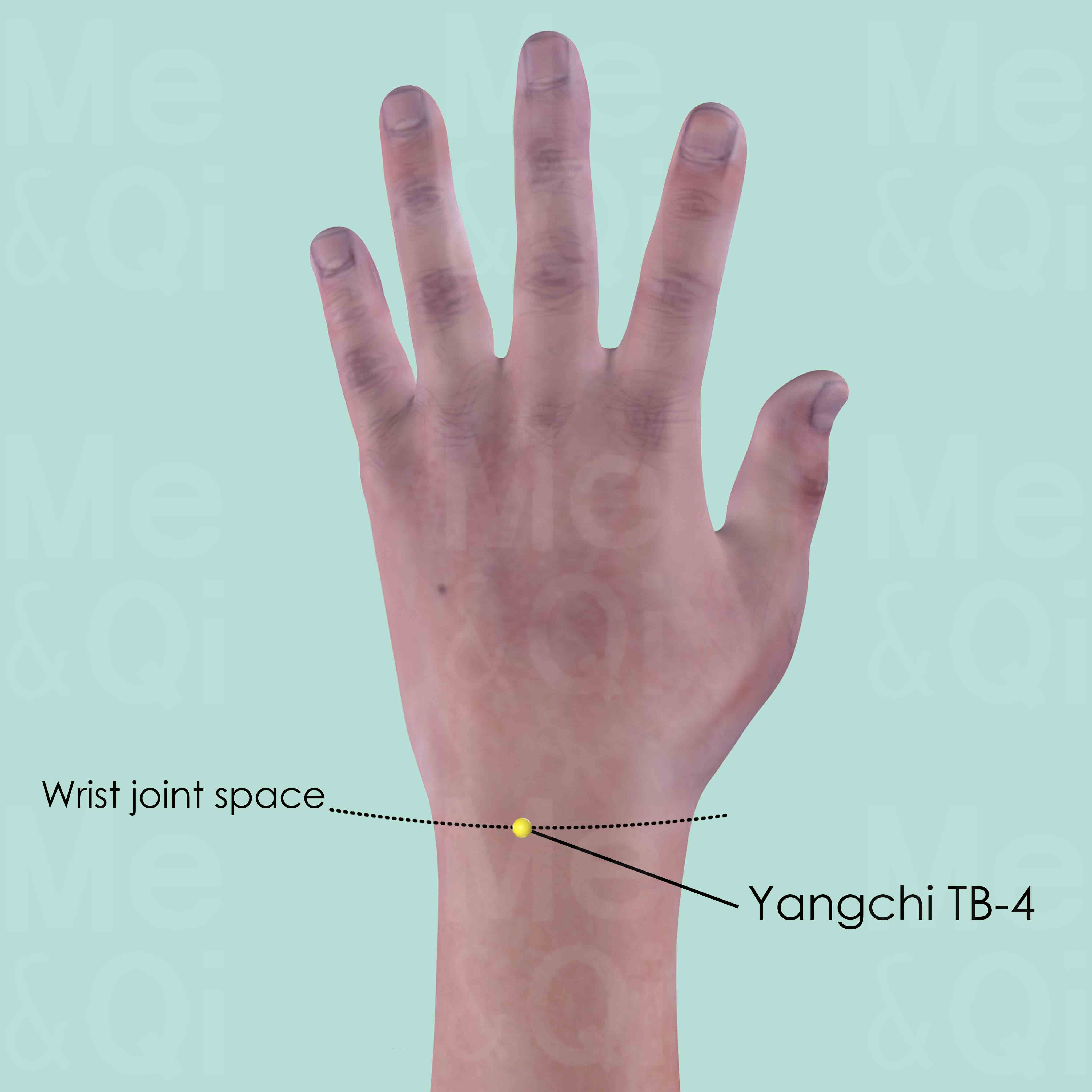
Yangchi TB-4
At the junction of the ulna carpal bones of the wrist dorsum, in the depression lateral to the tendon of extensor digitorum and extensor digiti minimi muscle.
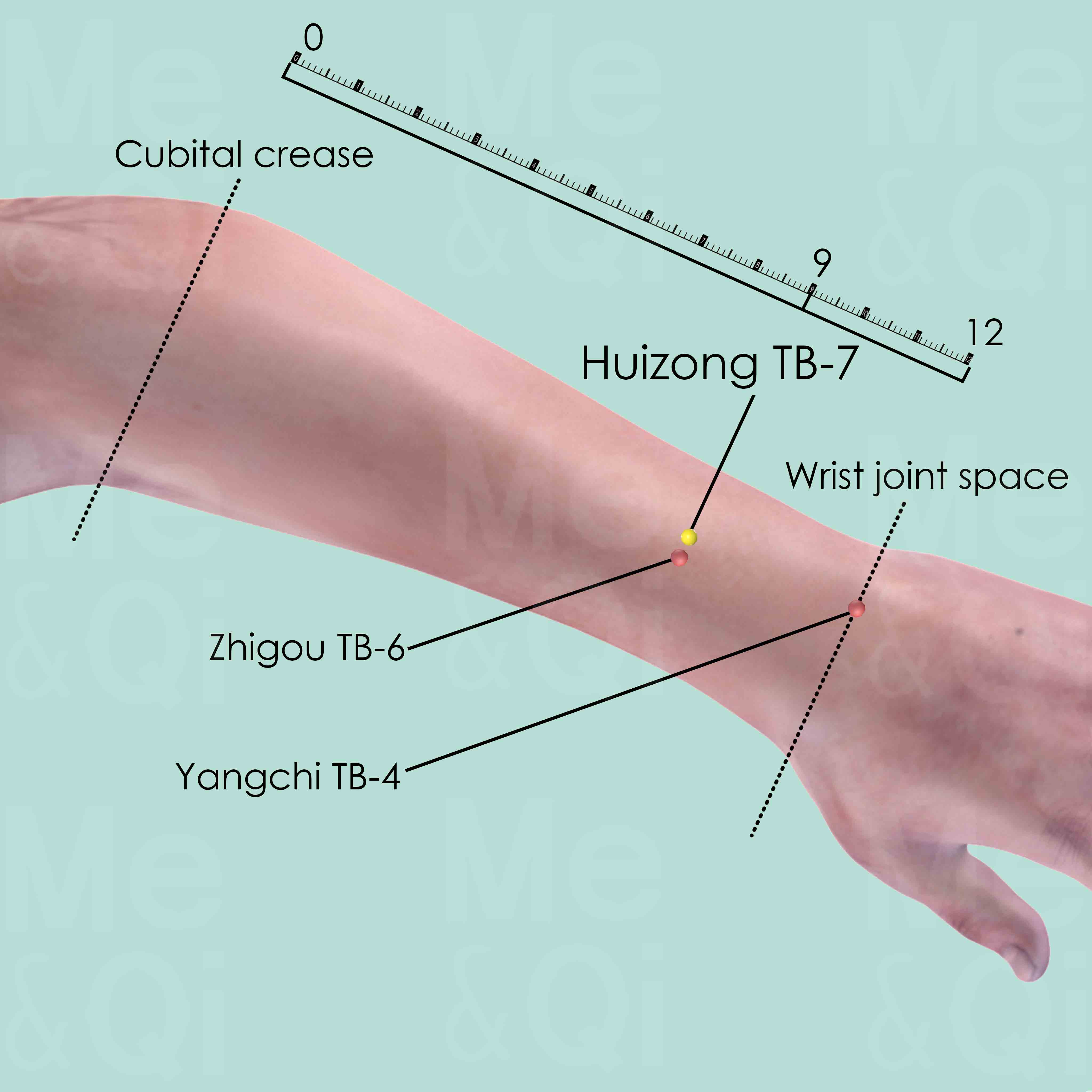
Huizong ST-7
3 cun proximal to the dorsal wrist joint space and 0.5 cun ulnar to the forearm center.
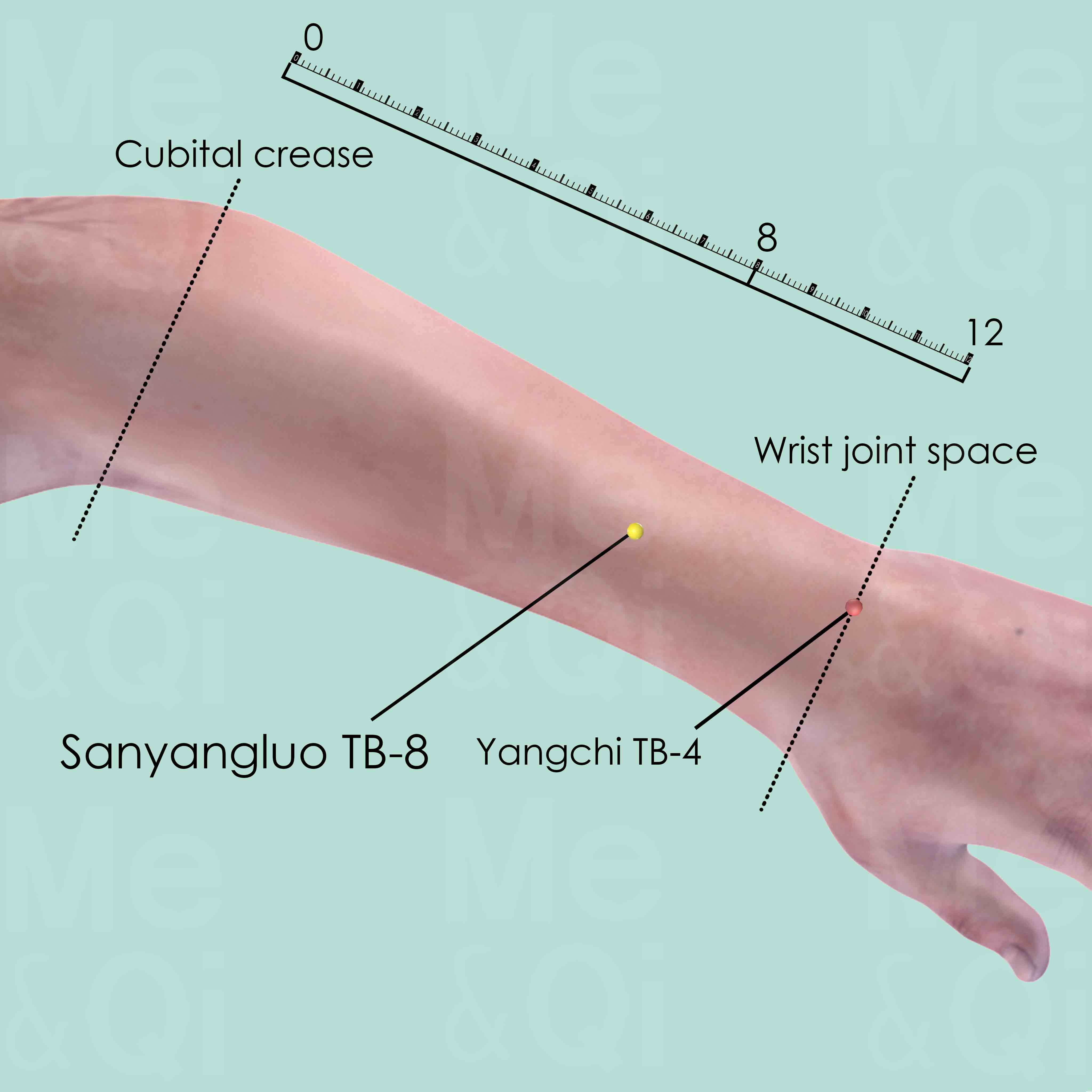
Sanyangluo TB-8
Between the radius and the ulna, 4 cun above Yangchi TB-4, which is on the dorsal wrist joint space.
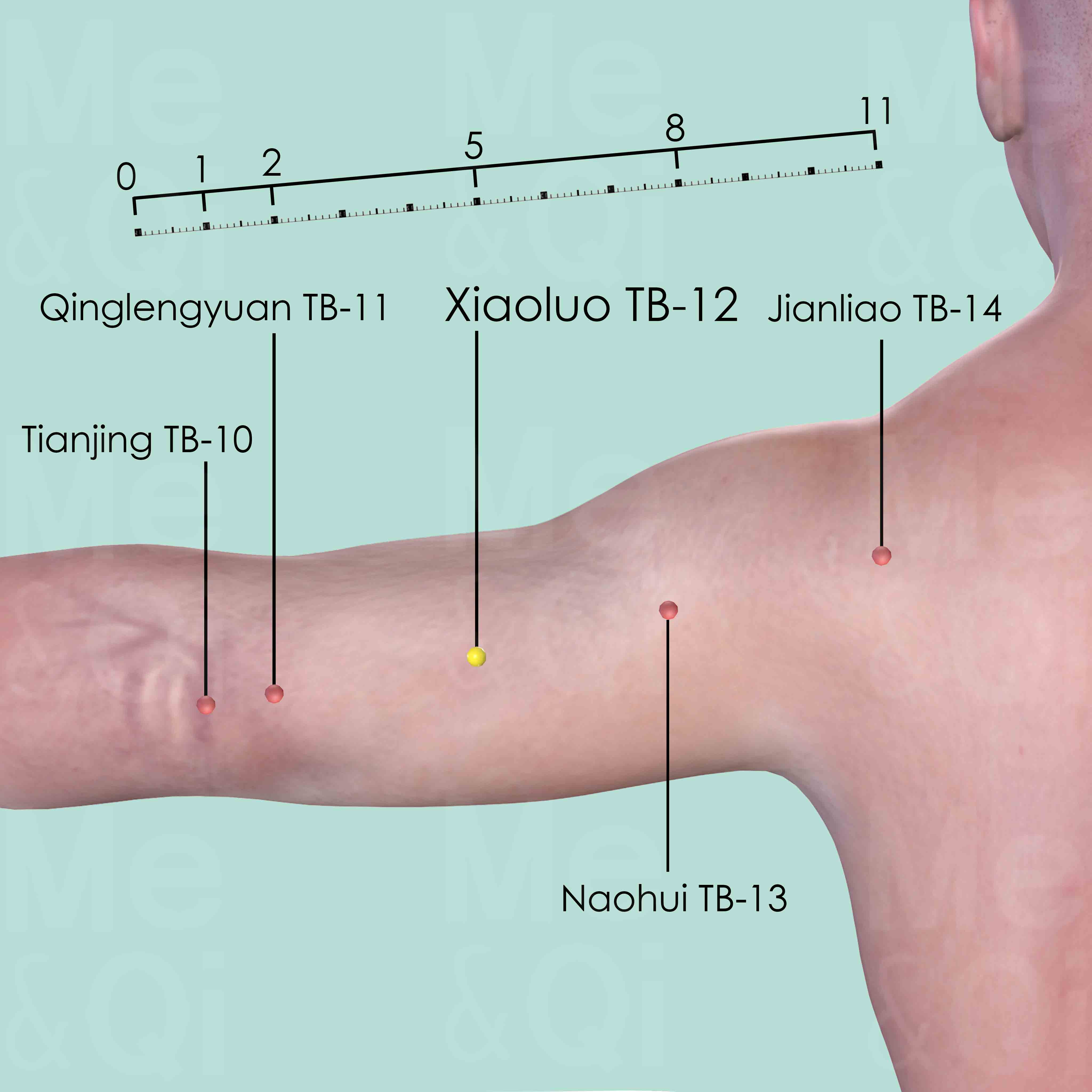
Xiaoluo TB-12
On the line joining the olecranon and Jianliao TB-14, midway between Qinglengyuan TB-11 and Naohui TB-13, 5 cun proximal to the olecranon. It is just on the lower end of bulge of the lateral head of triceps brachii when the forearm is in pronation.
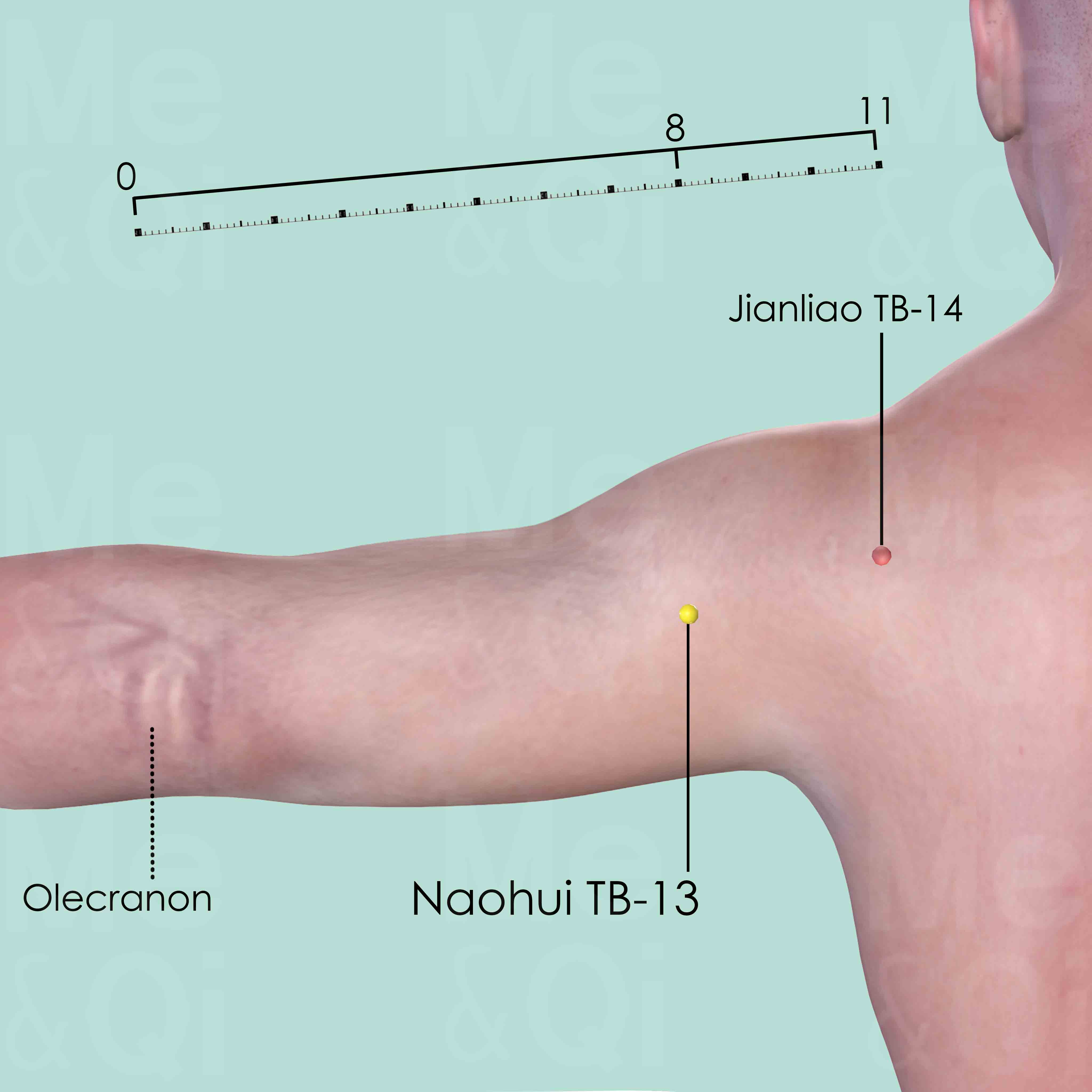
Naohui TB-13
On the line joining Jianliao TB-14 and the olecranon, 3 cun below Jianliao TB-14 which is at the lateral extremity of the acromion. Naohui TB-13 is on the posterior border of deltoid muscle.
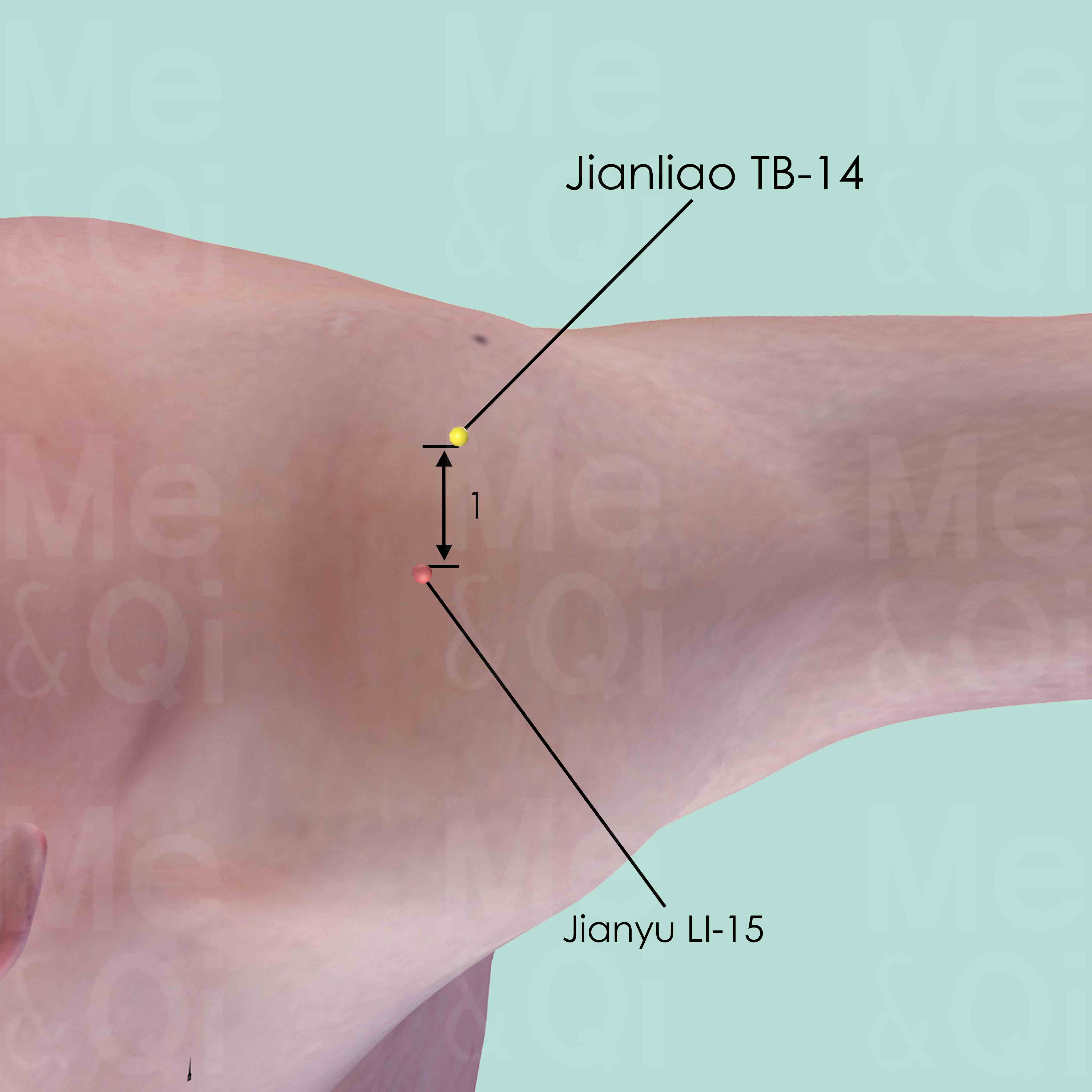
Jianliao TB-14
Posterior and inferior to the acromion, in the depression about 1 cun posterior to Jianyu LI-15.
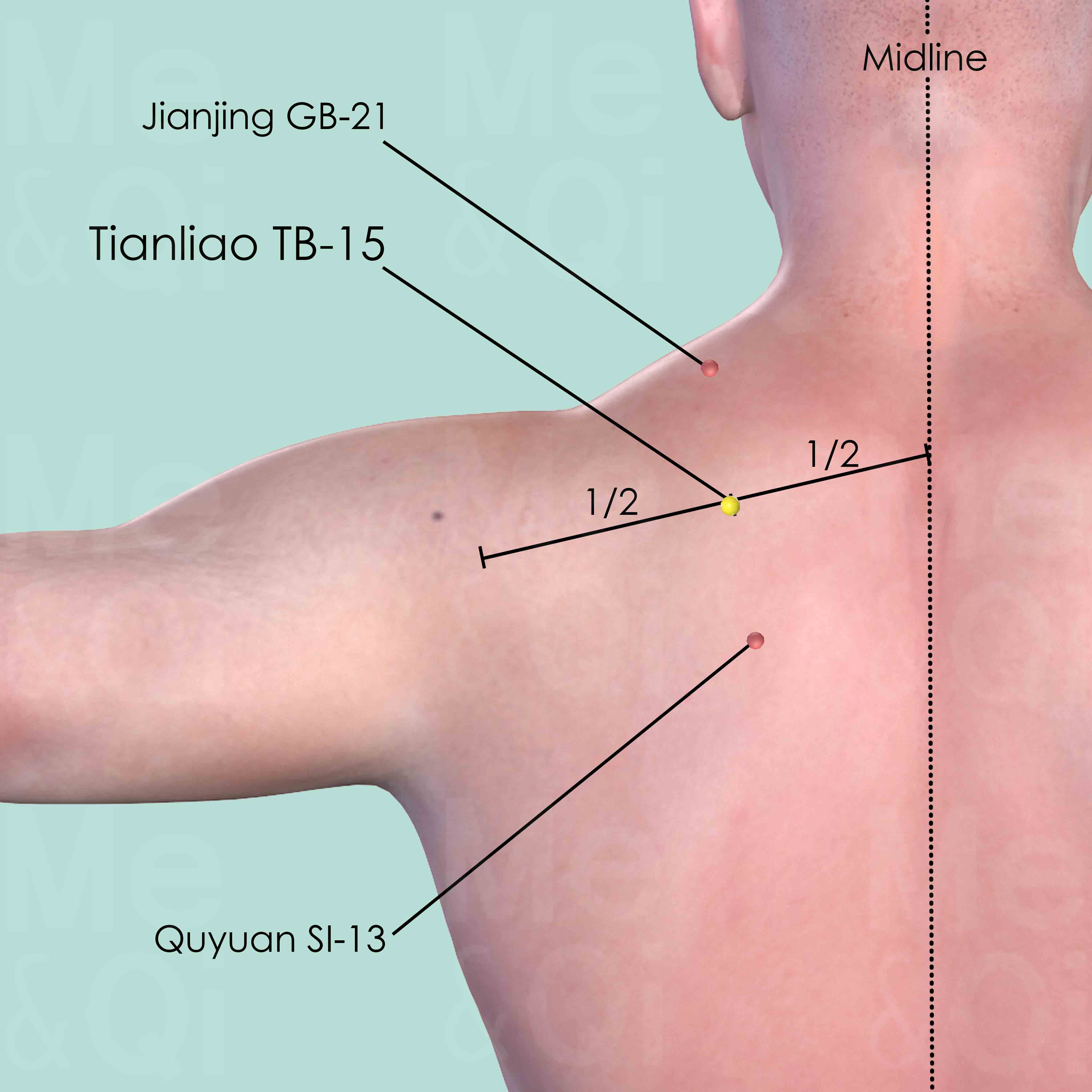
Tianliao TB-15
Midway between Jianjing GB-21 and Quyuan SI-13, on top of the superior angle of the scapula.

Shaoze SI-1
On the ulnar side of the little finger, about 0.1 cun posterior to the corner of the nail.
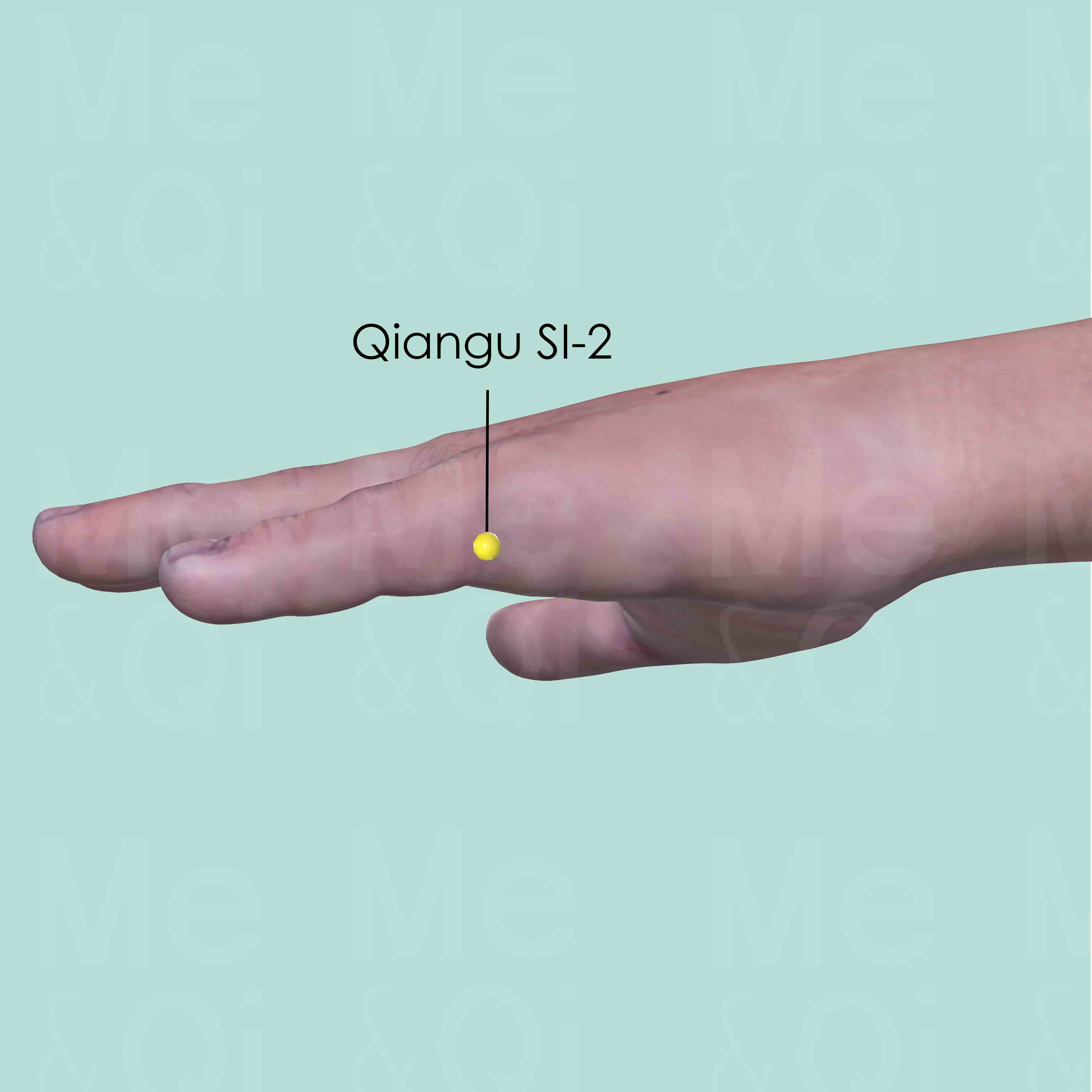
Qiangu SI-2
On the ulnar aspect of the little finger, distal to the metacarpophalangeal joint, at the junction of the shaft and the base of the proximal phalanx.
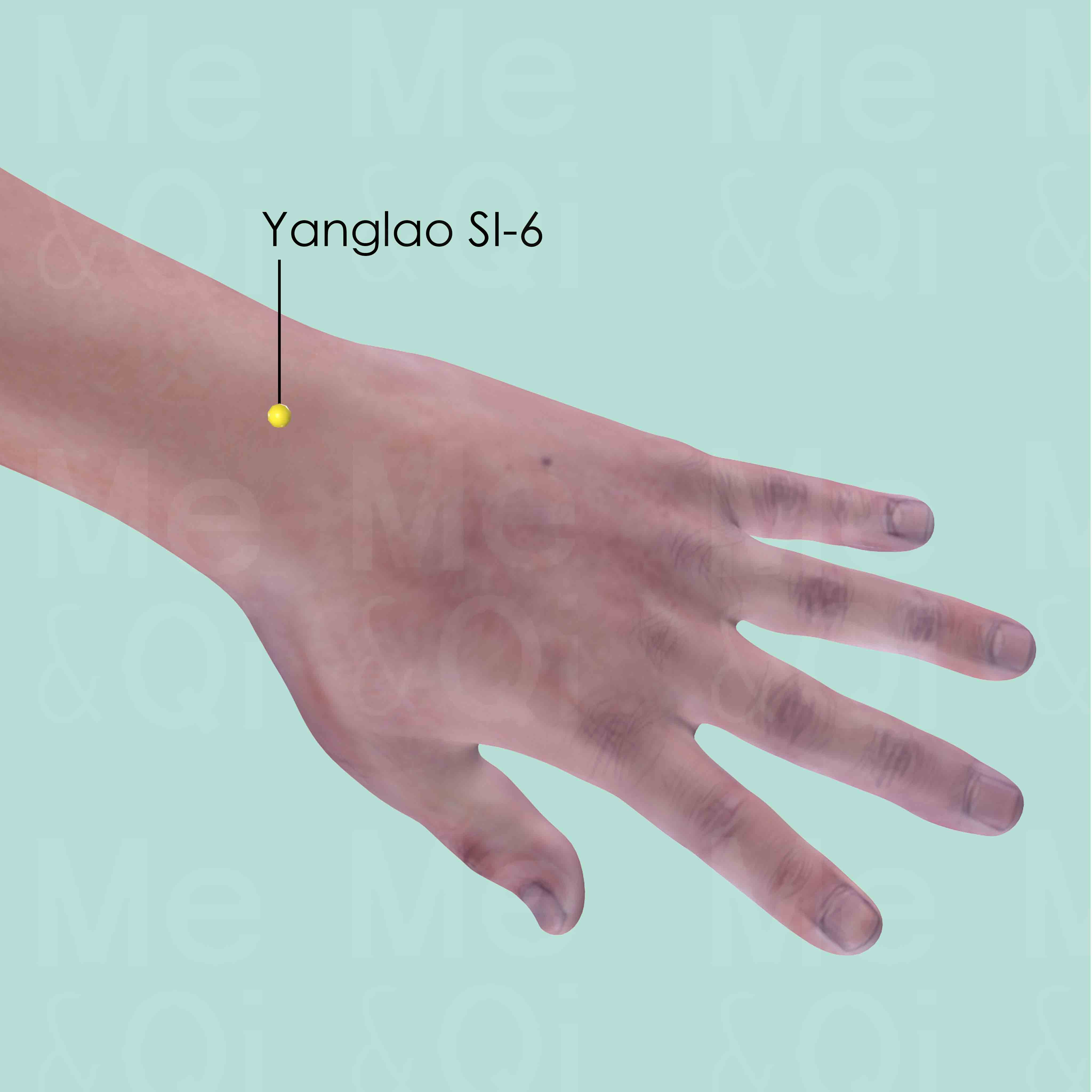
Yanglao SI-6
Dorsal to the head of the ulna. When the palm faces the chest, Yanglao SI-6 is in the bony depression on the radial side of the styloid process of the ulna.
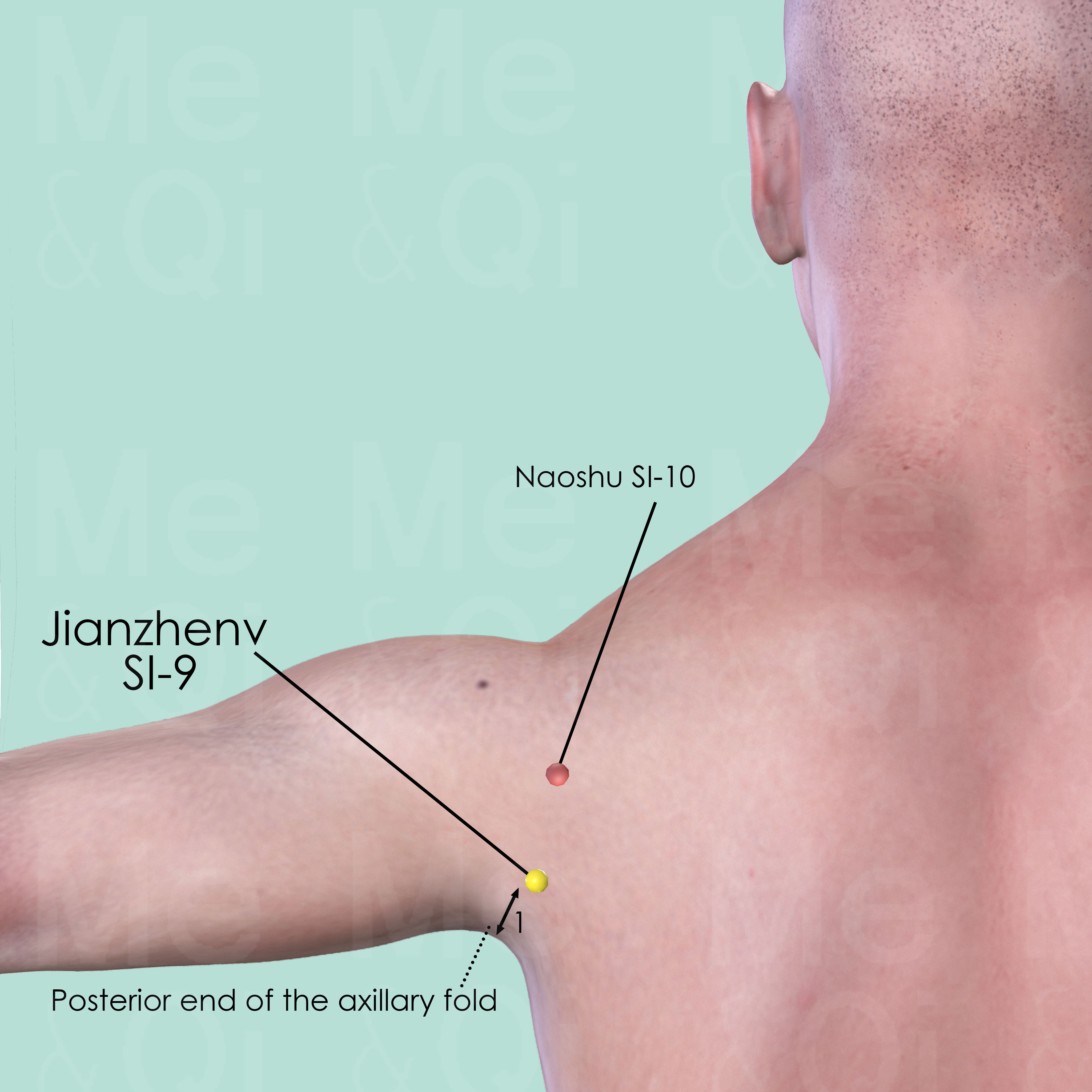
Jianzhen SI-9
Posterior and inferior to the shoulder joint. When the arm is adducted, Jianzhen SI-9 is 1 cun above the posterior end of the axillary fold. Naoshu SI-10 is located directly above Jianzhen SI-9.
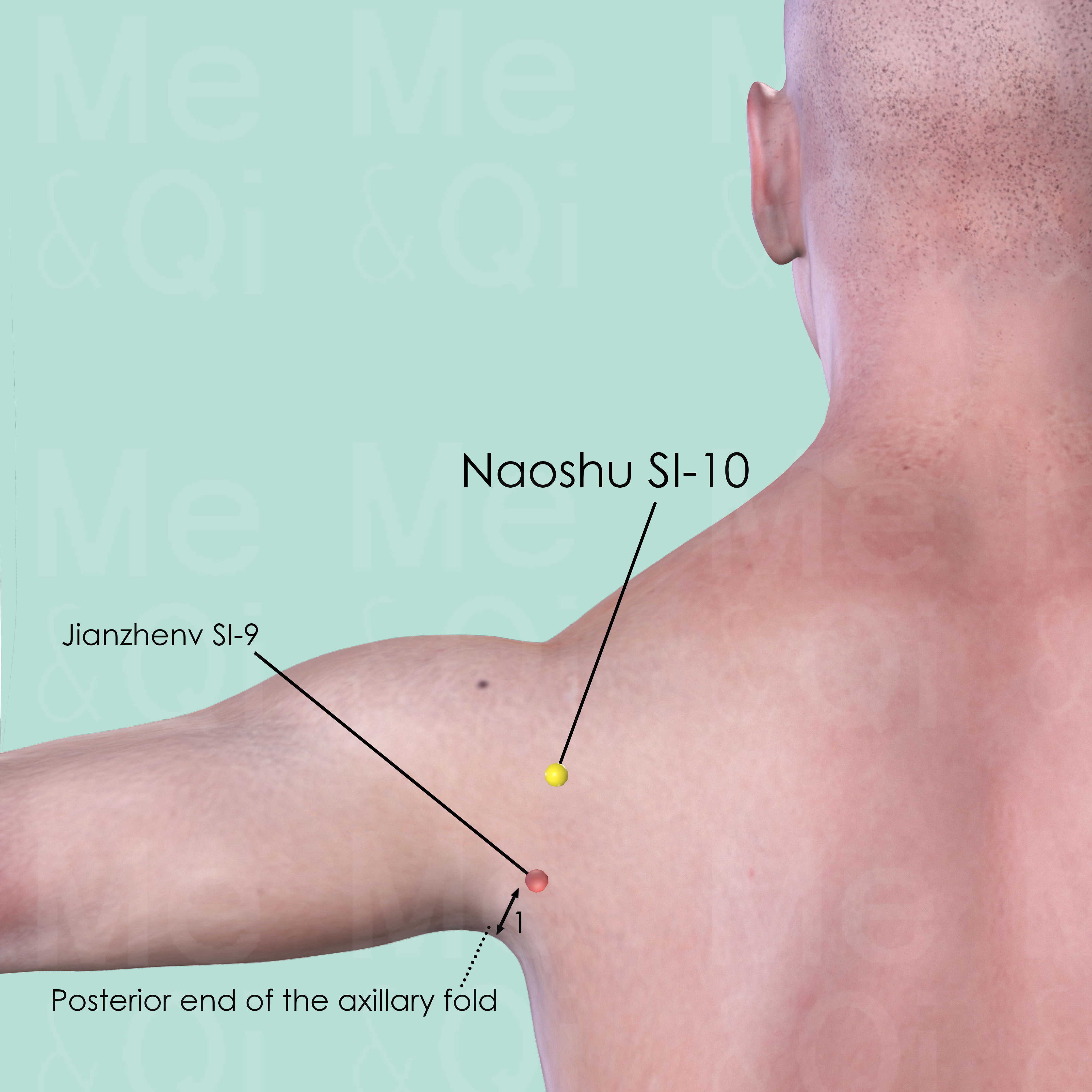
Naoshu SI-10
When the arm is adducted, Naoshu SI-10 is directly above JianZhen SI-9, in the depression inferior and lateral to the scapular spine.
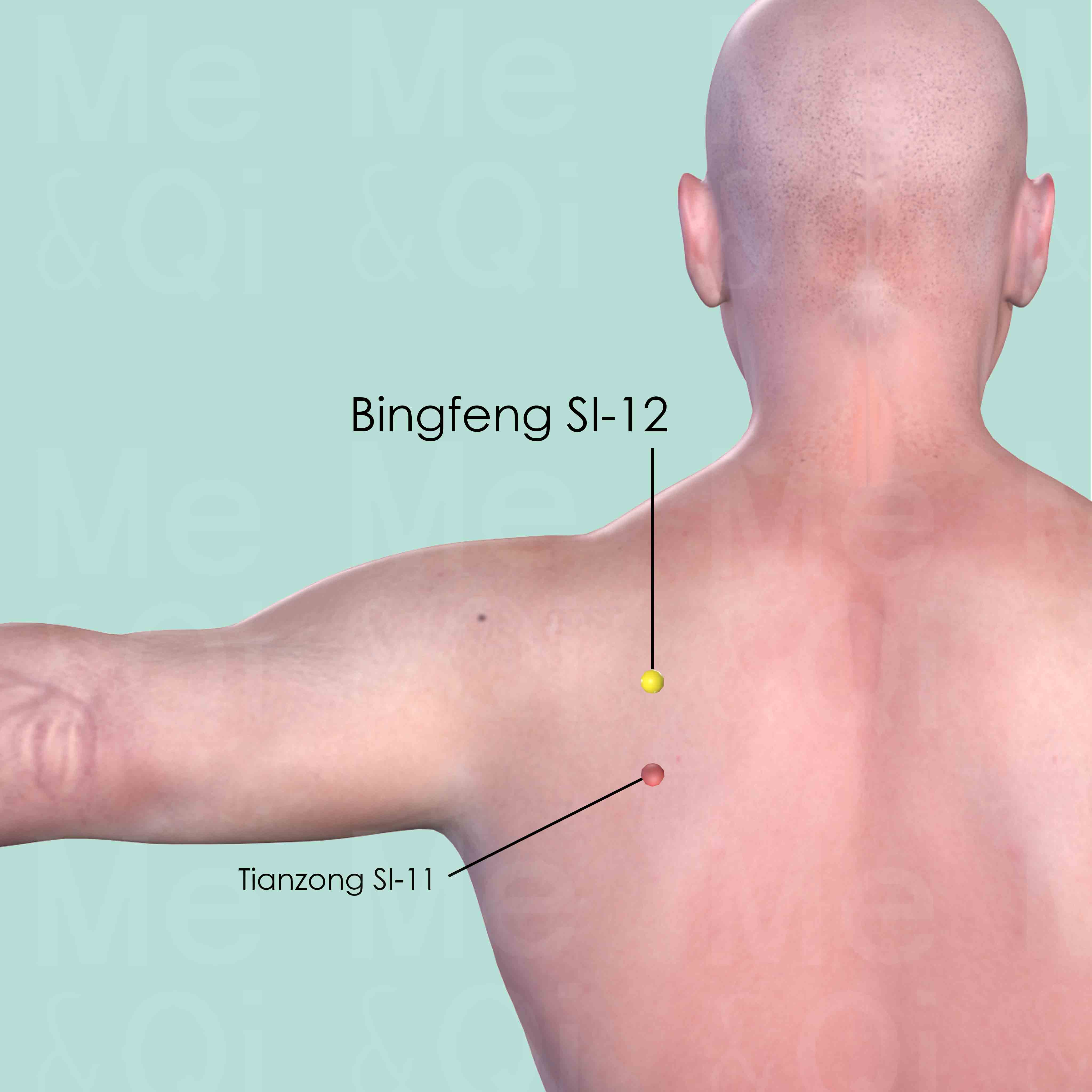
Bingfeng SI-12
In the center of the suprascapular fossa, directly above Tianzong SI-11. When the arm is lifted, the point is at the site of the depression.
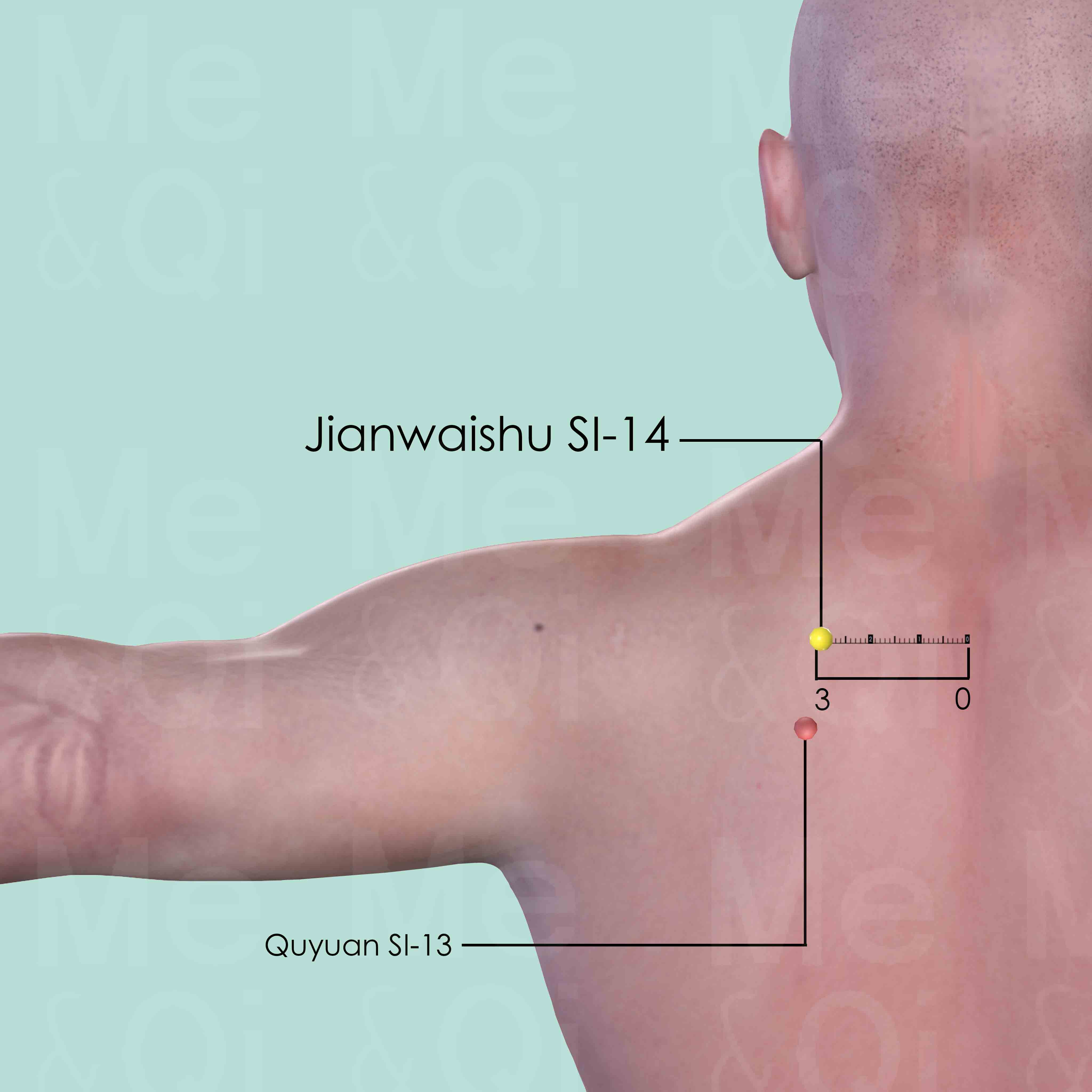
Jianwaishu SI-14
3 cun lateral to the lower border of the spinous process of the 1st thoracic verrtebra (T1), on the vertical line drawn from the levator scapulae muscle.
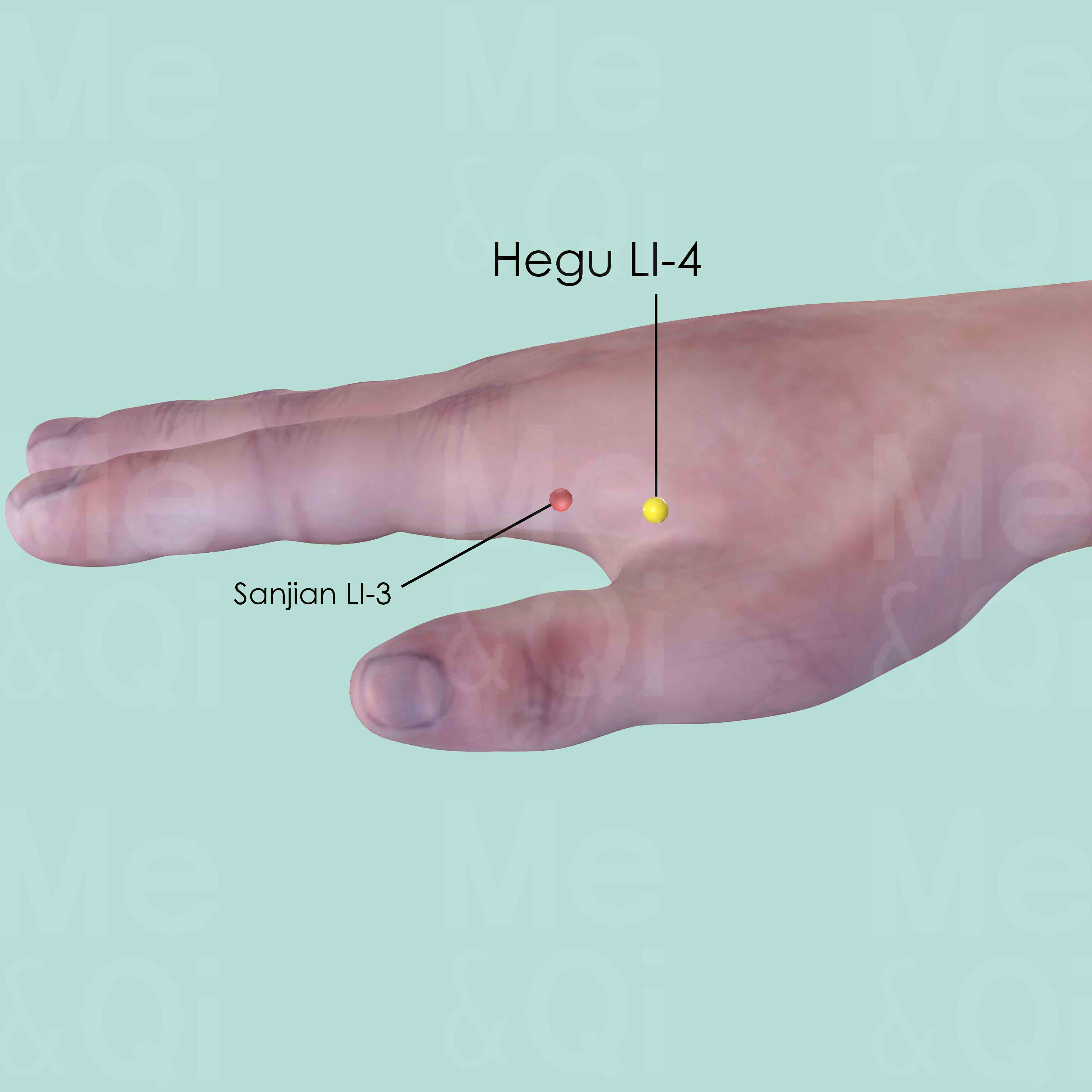
Hegu LI-4
Between the 1st and 2nd metacarpal bones, approximately in the middle of the 2nd metacarpal bone on the radial side.
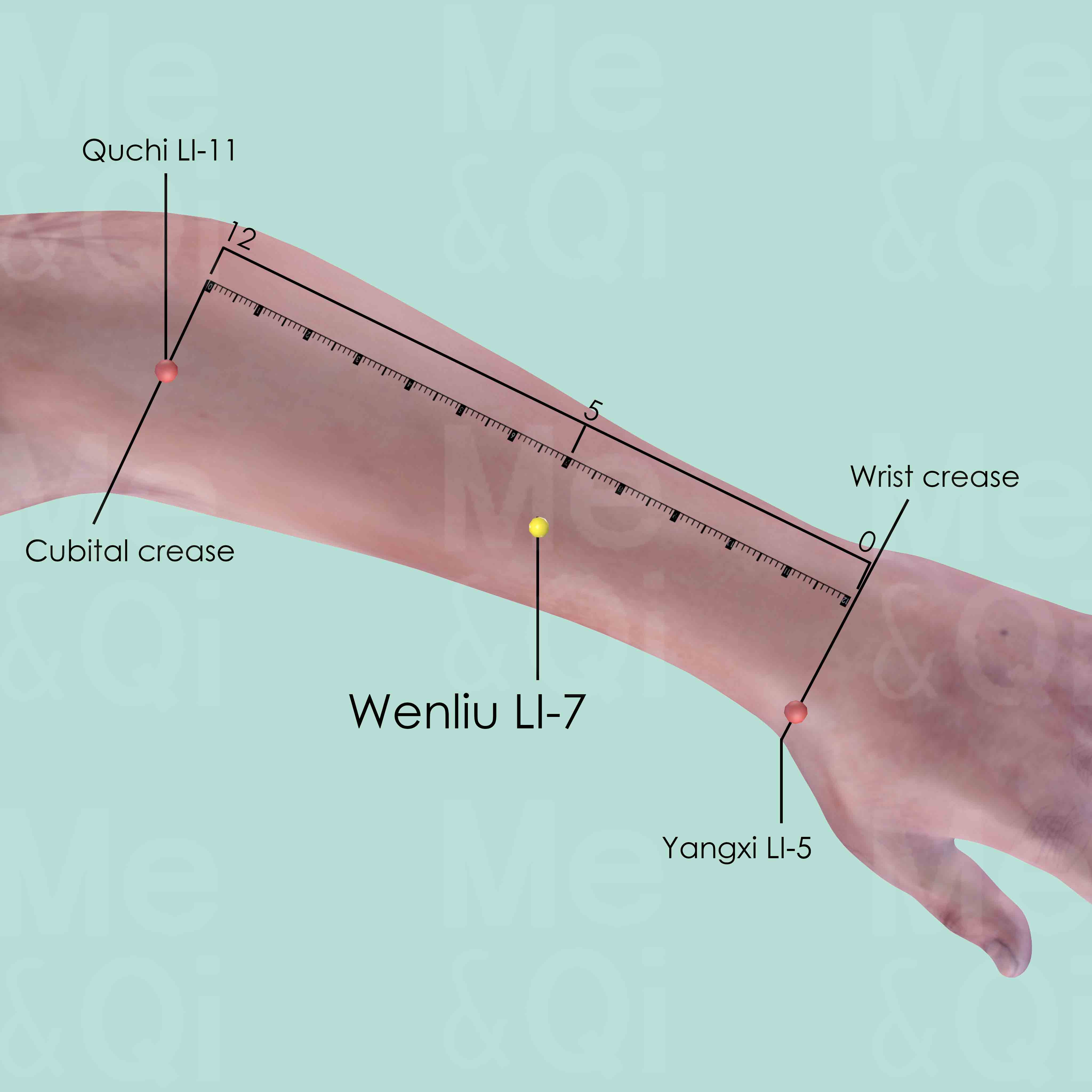
Wenliu LI-7
When a fist is made, with the ulnar side downward and elbow flexed, the point is 5 cun above Yangxi LI-5 at the wrist crease, 1 cun distal to the midpoint of the line joining Yangxi LI-5 and Quchi LI-11.
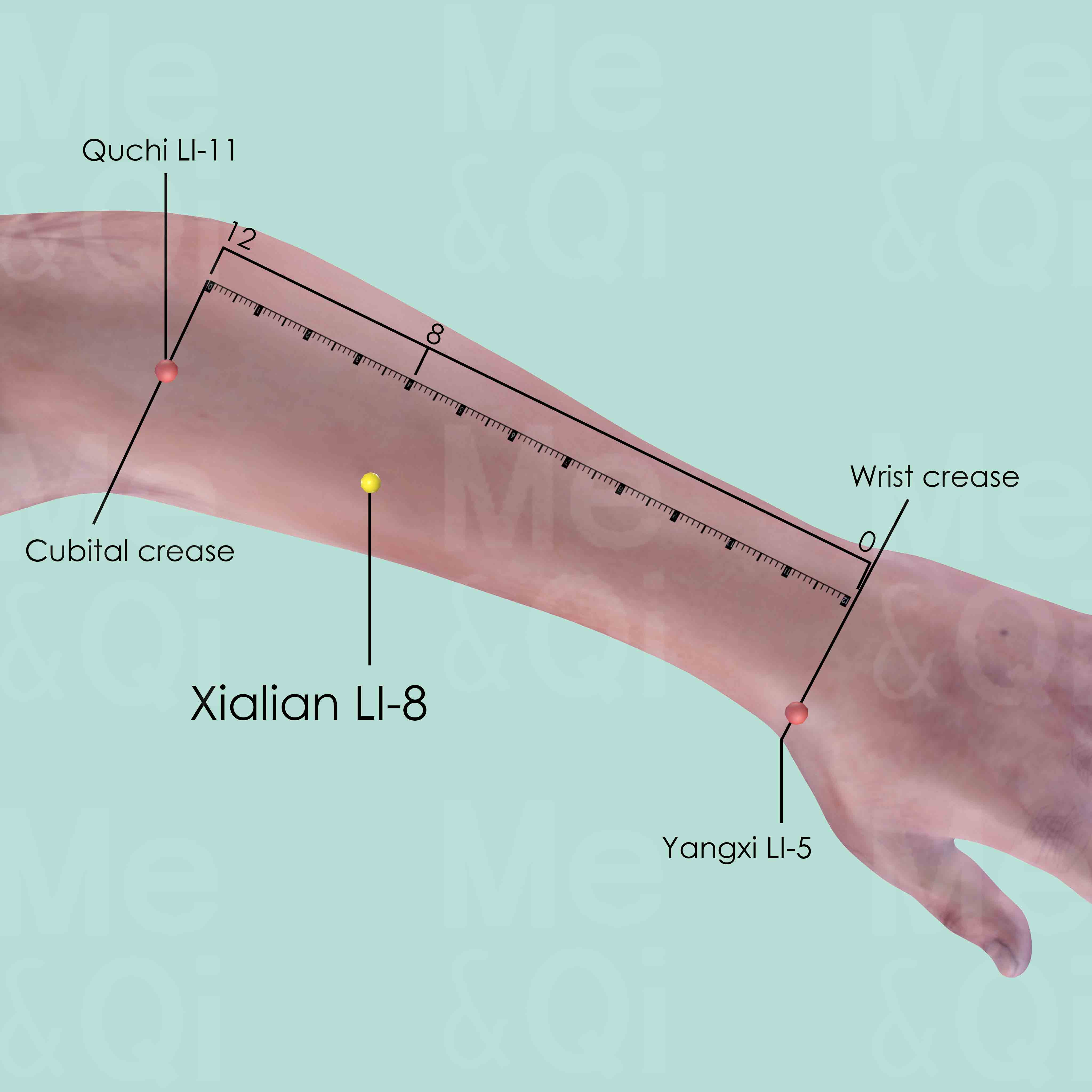
Xialian LI-8
When a fist is made, with the ulnar side downward and elbow flexed, the point is 4 cun distal to Quchi LI-11 of the line joining Yangxi LI-5 and Quchi LI-11.
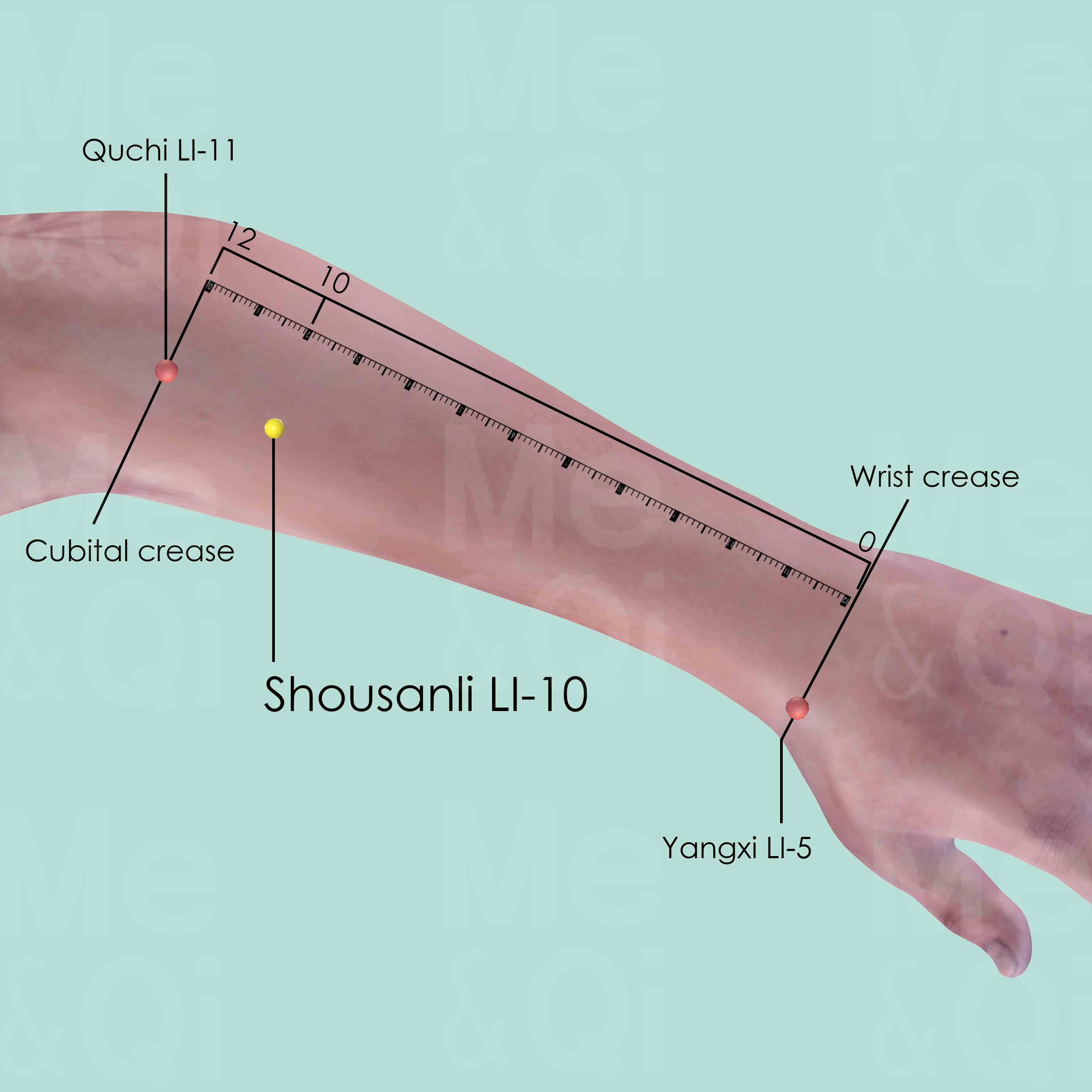
Shousanli LI-10
When a fist is made, with the ulnar side downward and elbow flexed, the point is 2 cun distal to Quchi LI-11 of the line joining Yangxi LI-5 and Quchi LI-11.
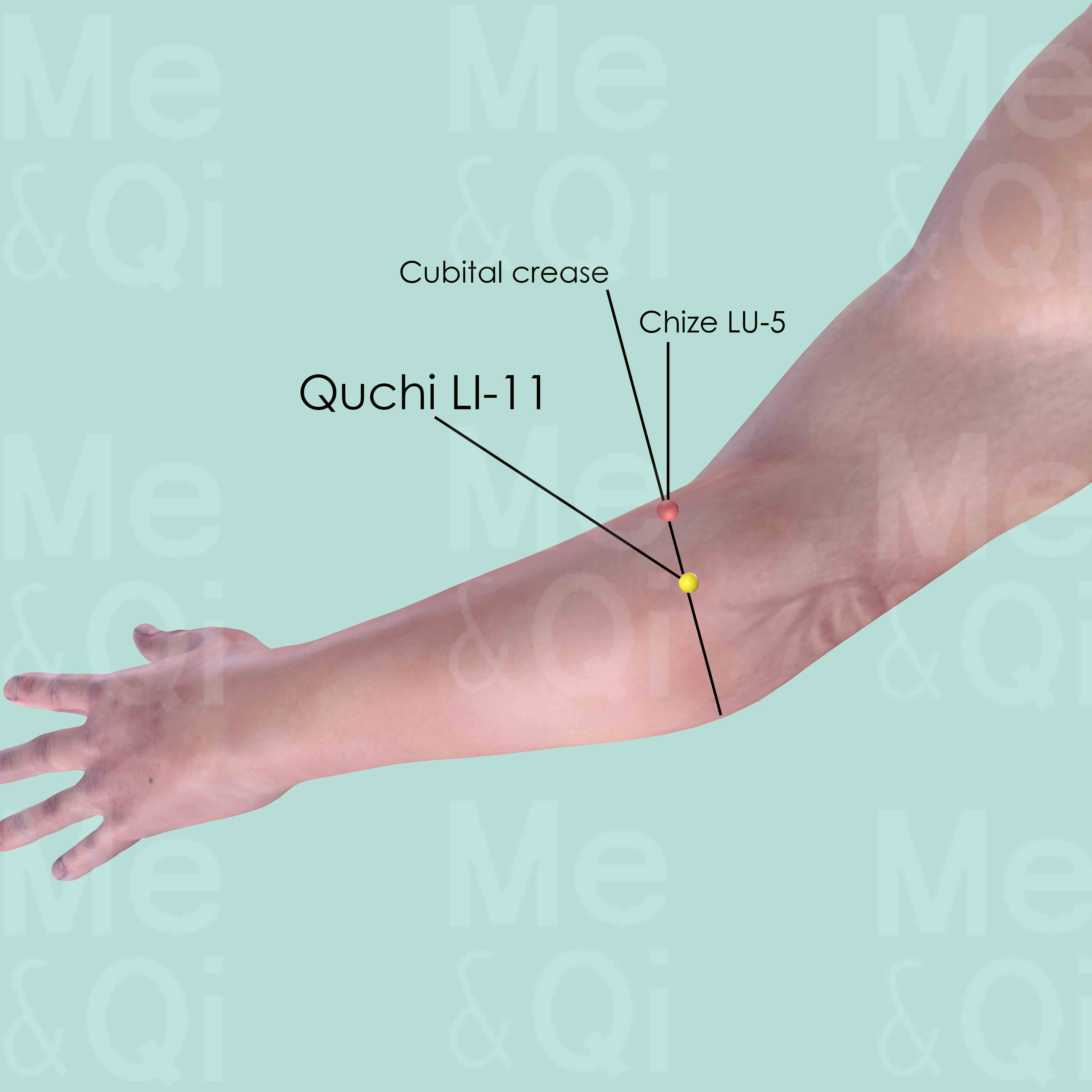
Quchi LI-11
When the elbow is flexed, Quchi LI-11 is in the depression at the lateral end of the cubital crease, midway between Chize LU-5 and the lateral epicondyle of the humerus.
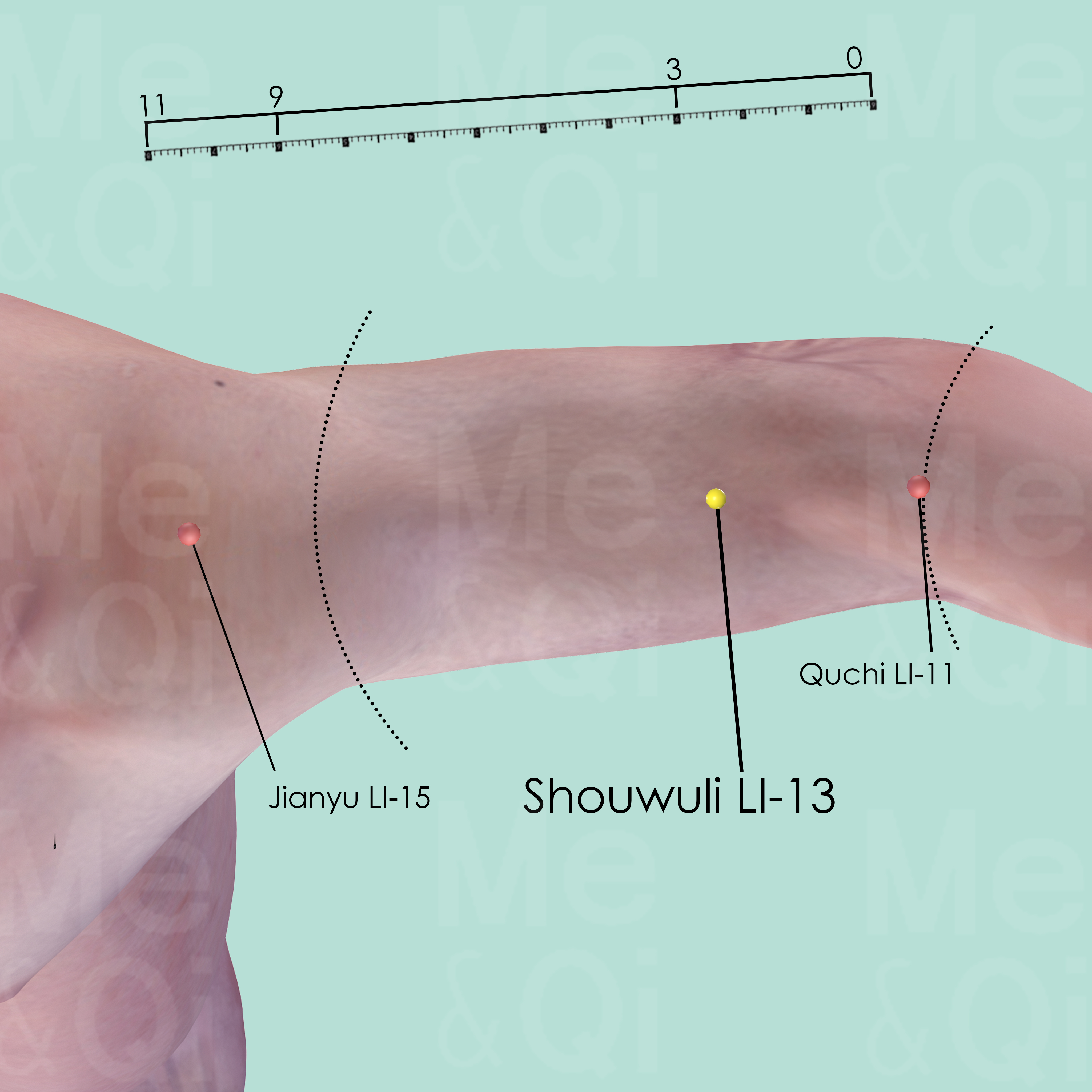
Shouwuli LI-13
Superior to the lateral epicondyle of the humerus, 3 cun above Quchi LI-11, on the line connecting Quchi LI-11 and Jianyu LI-15.
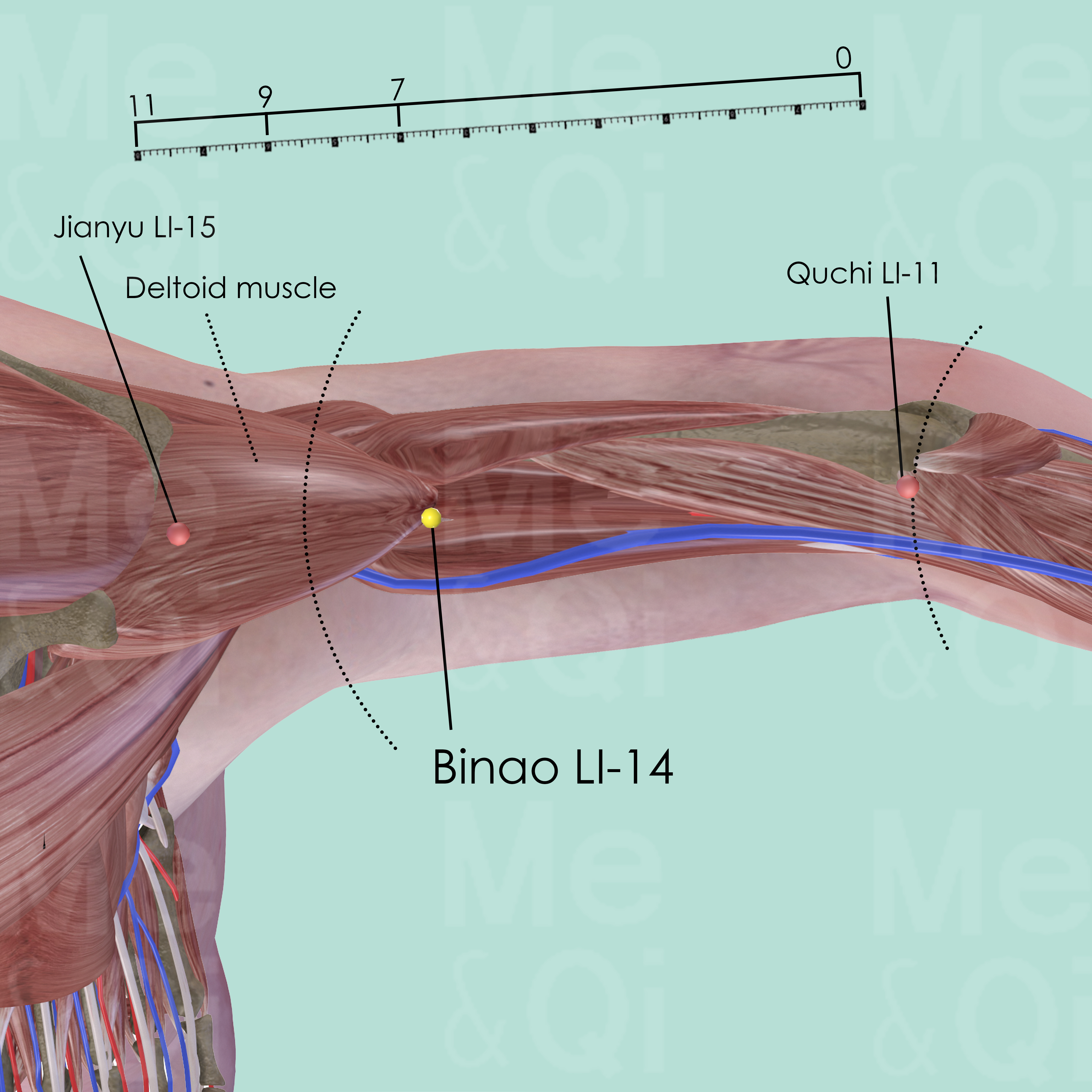
Binao LI-14
On the radial side of the humerus, superior to the lower end of deltoid muscle, on the line connecting Quchi LI-11 and Jianyu LI-15, 7 cun proximal to Quchi LI-11.
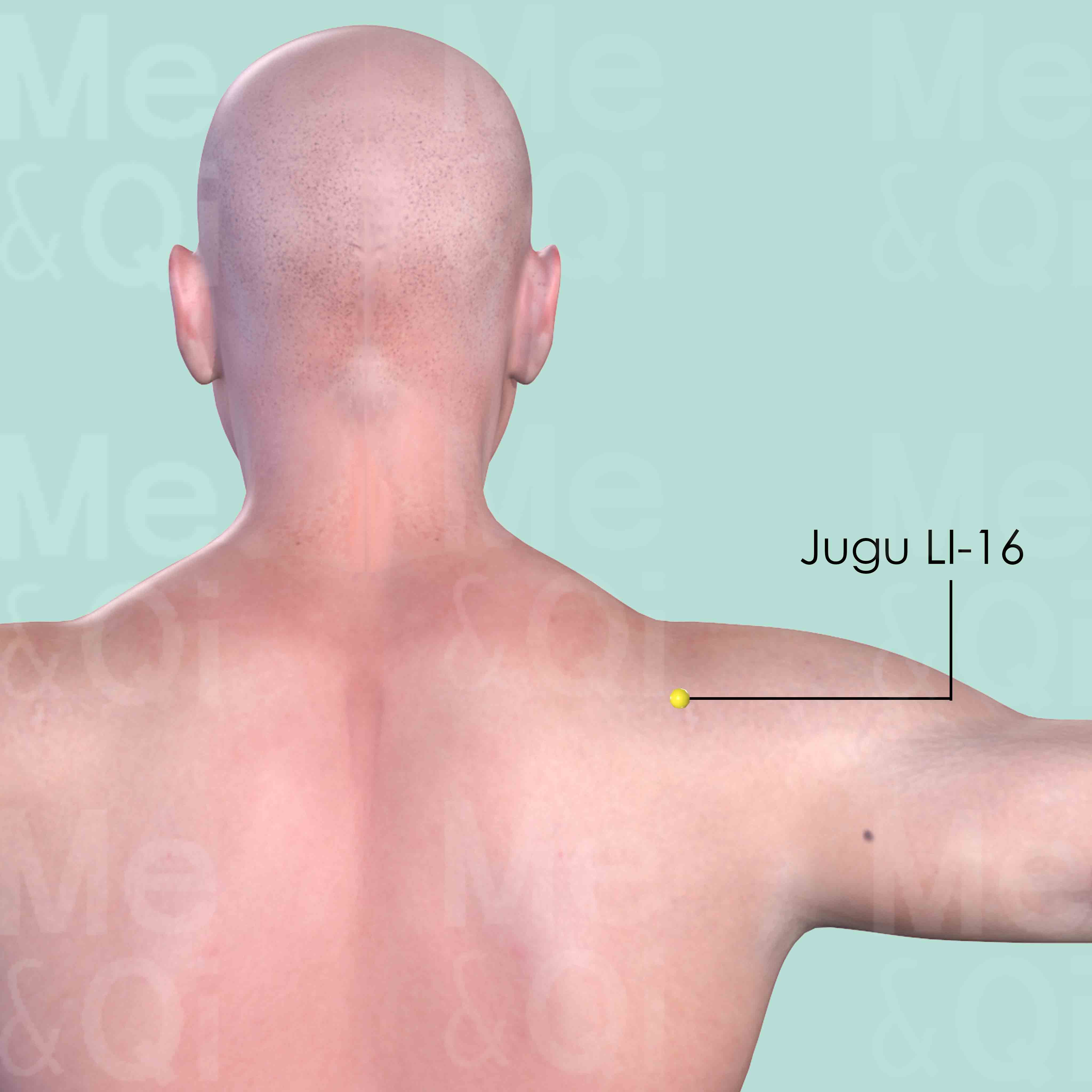
Jugu LI-16
In the upper aspect of the shoulder, in the depression between the acromio-clavicular joint and the scapular spine.
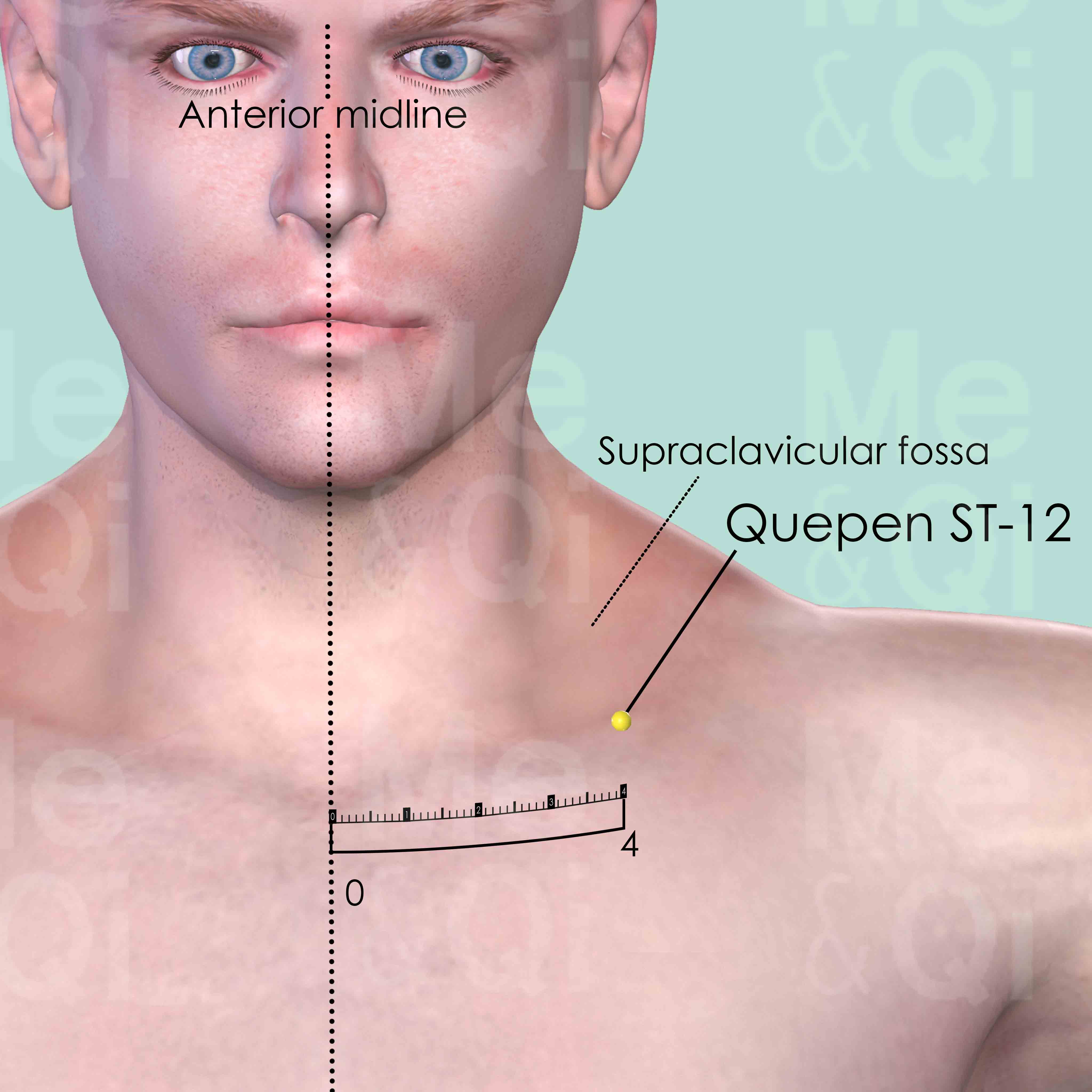
Quepen ST-12
About 4 cun lateral to the anterior midline, in the supraclavicular fossa, superior to the midpoint of the clavicle.
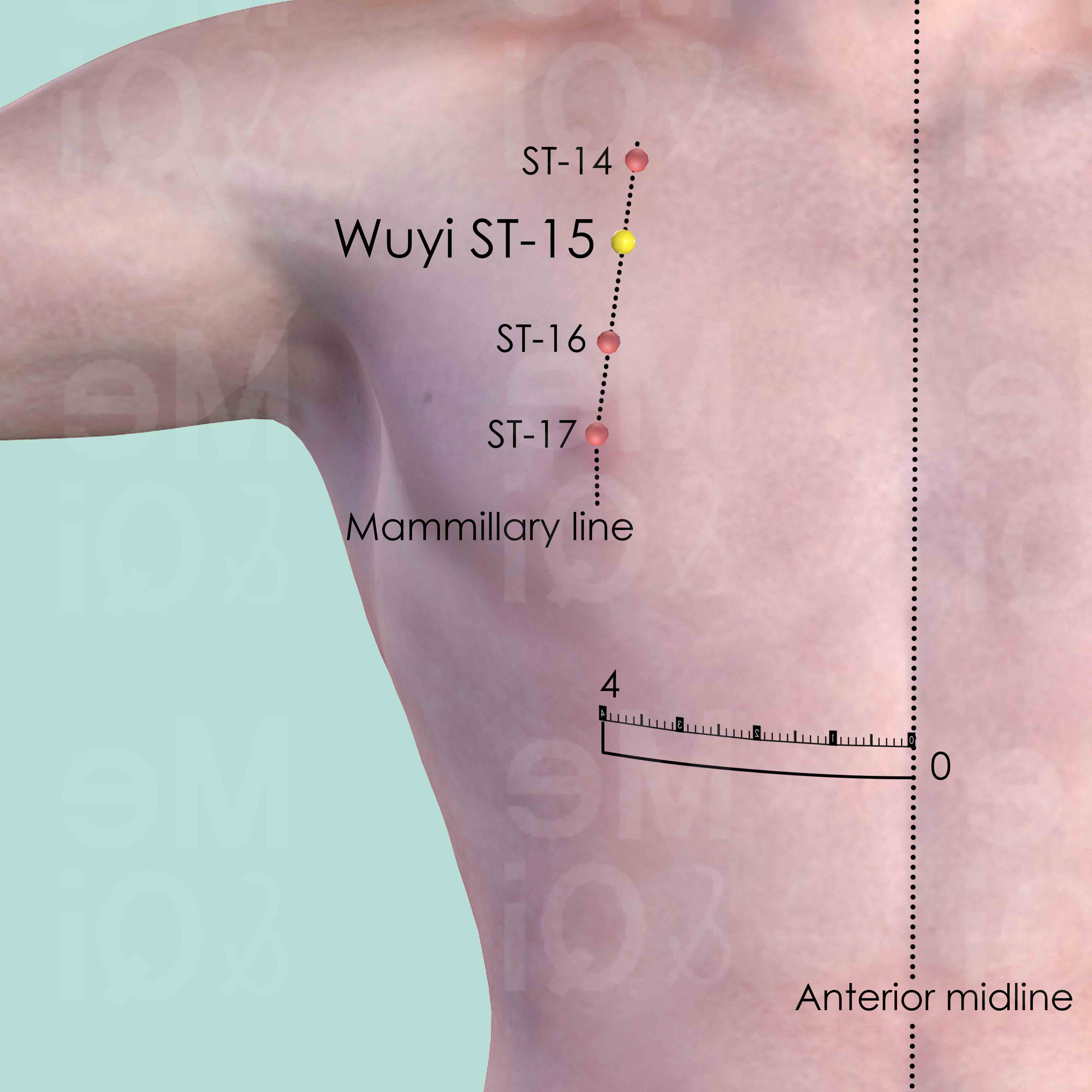
Wuyi ST-15
In the 2nd intercostal space, on the mammillary line, 4 cun lateral to the anterior midline.
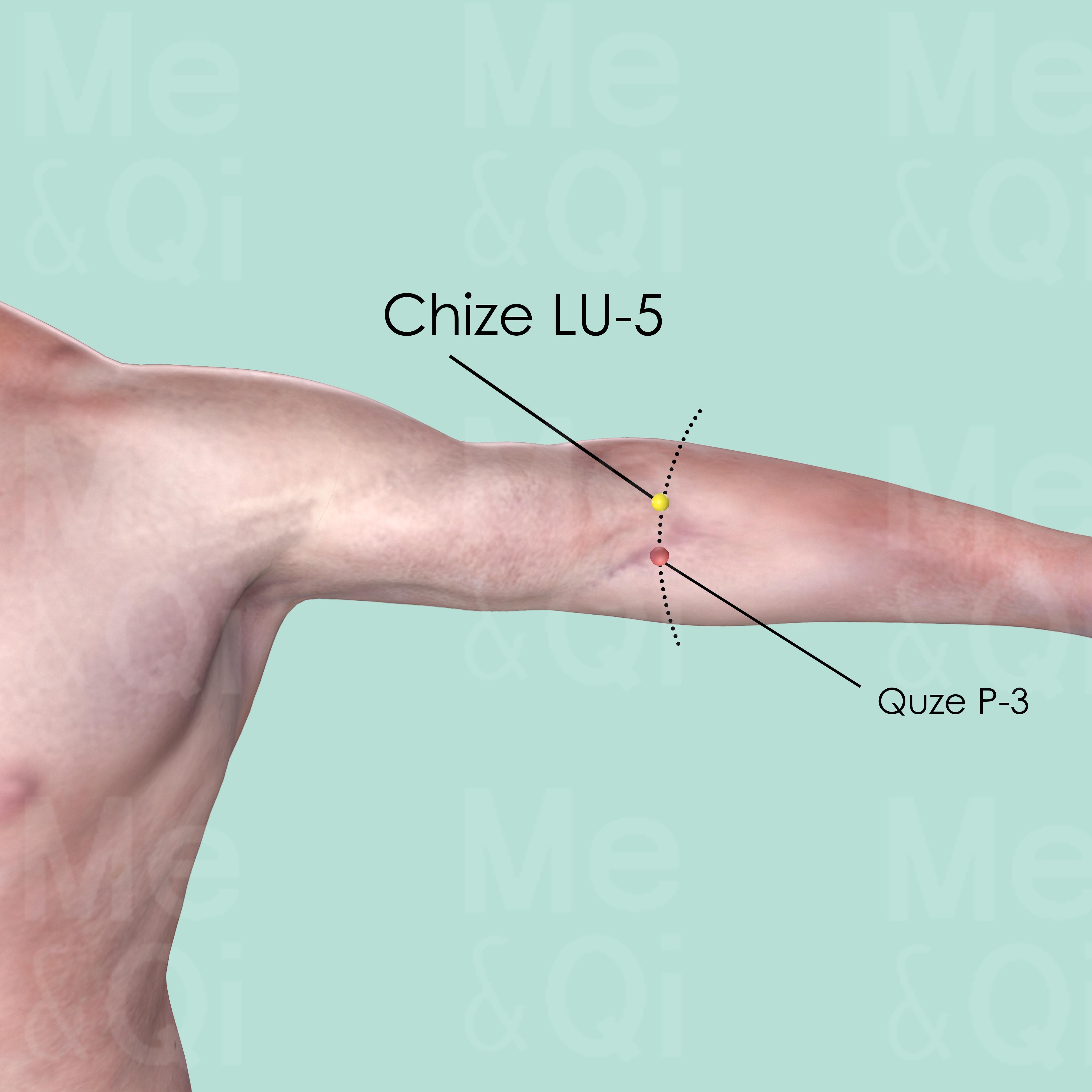
Chize LU-5
On the cubital crease, on the redial aspect of the biceps tendon. It can be easily identified when the elbow is slightly flexed.
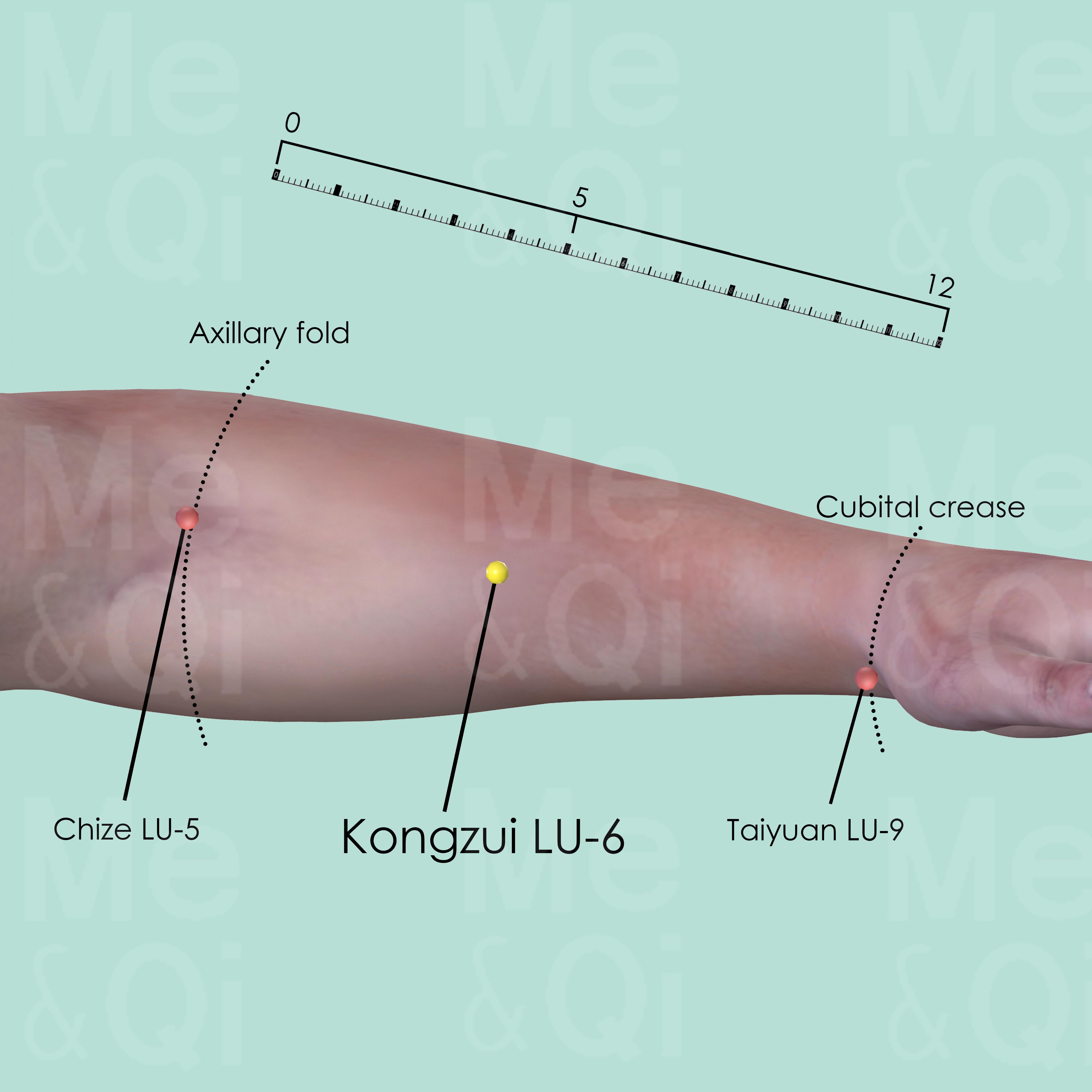
Kongzui LU-6
On the palmar aspect of the forearm, on the line joining Taiyuan LU-9 and Chize LU-5, 7 cun above Taiyuan LU-9.
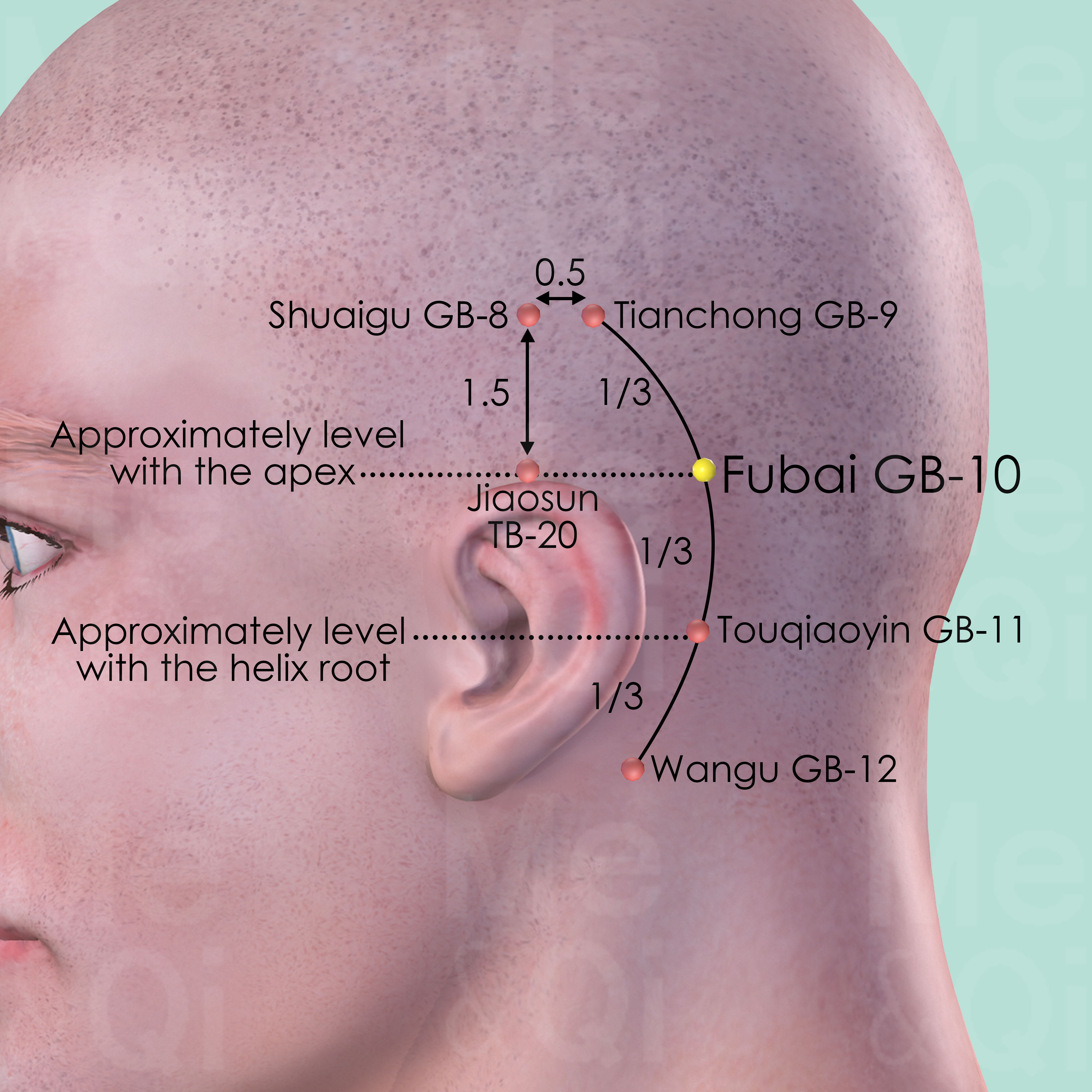
Fubai GB-10
Posterior and superior to the mastoid process, at the junction of the upper third and the two lower thirds of the curved line connecting Tianchong GB-9 and Wangu GB-12.
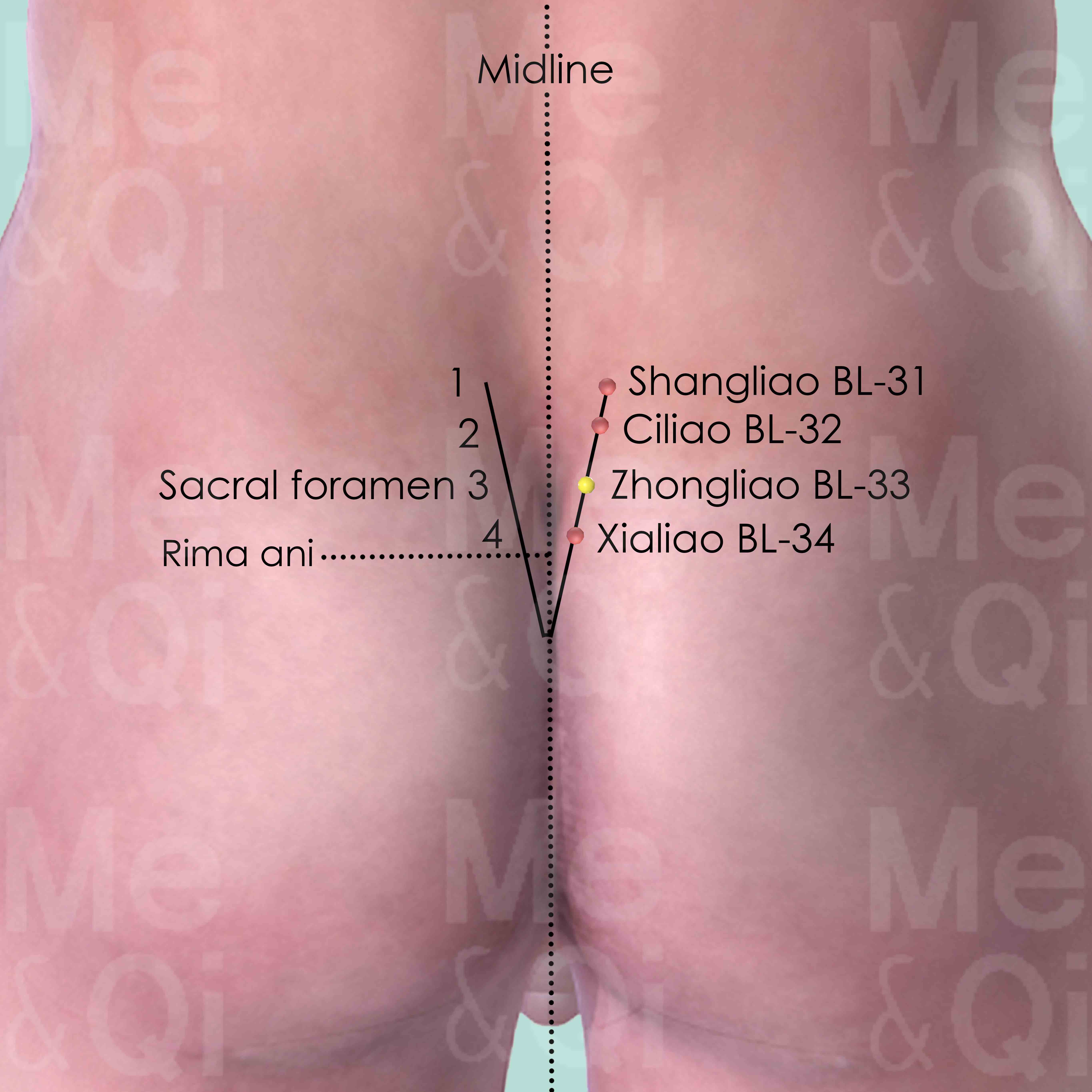
Zhongliao BL-33
In the 3rd posterior sacral foramen, between the posterior superior iliac spine and the midline.
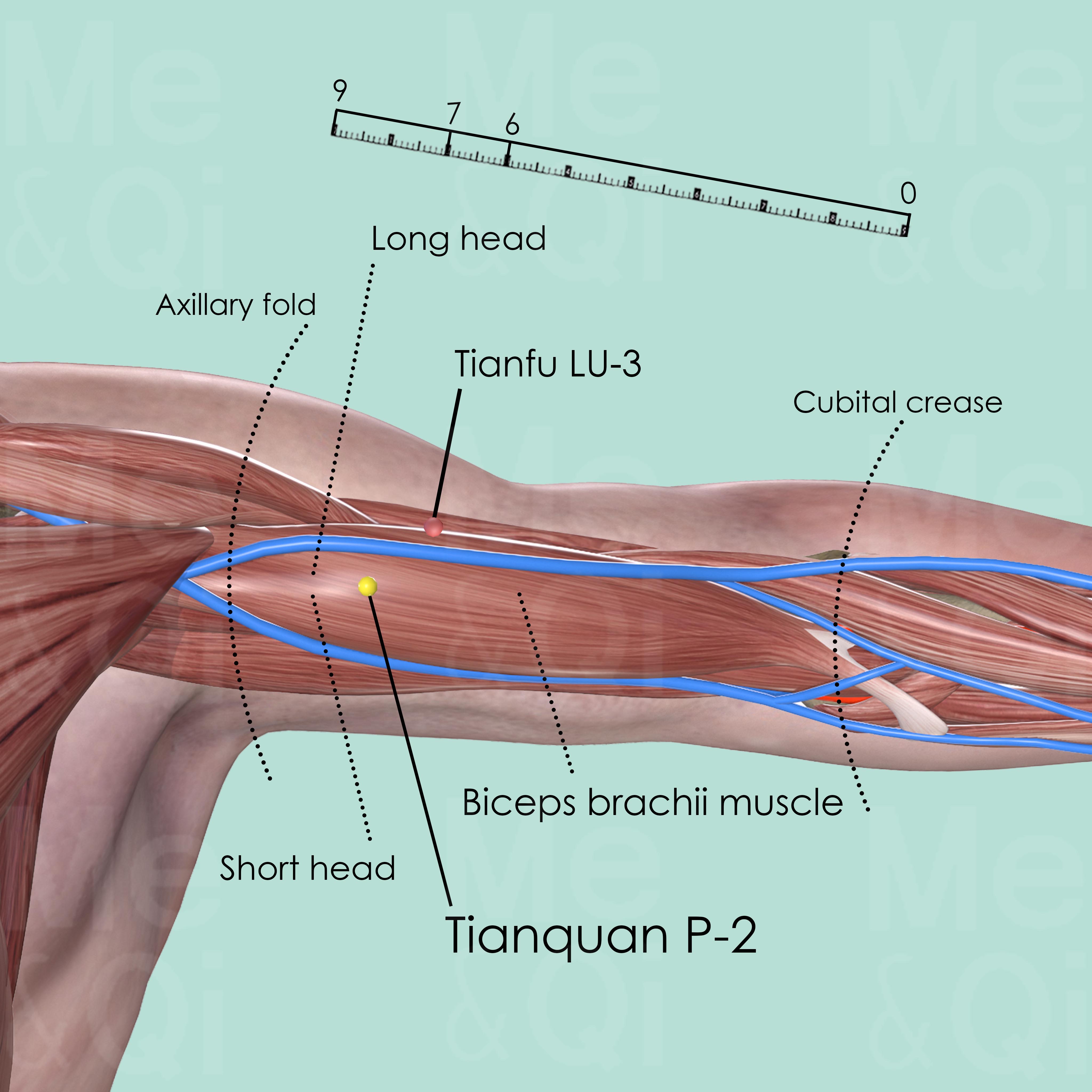
Tianquan P-2
2 cun below the end of the anterior axillary fold, between the two heads of biceps brachii muscle.

